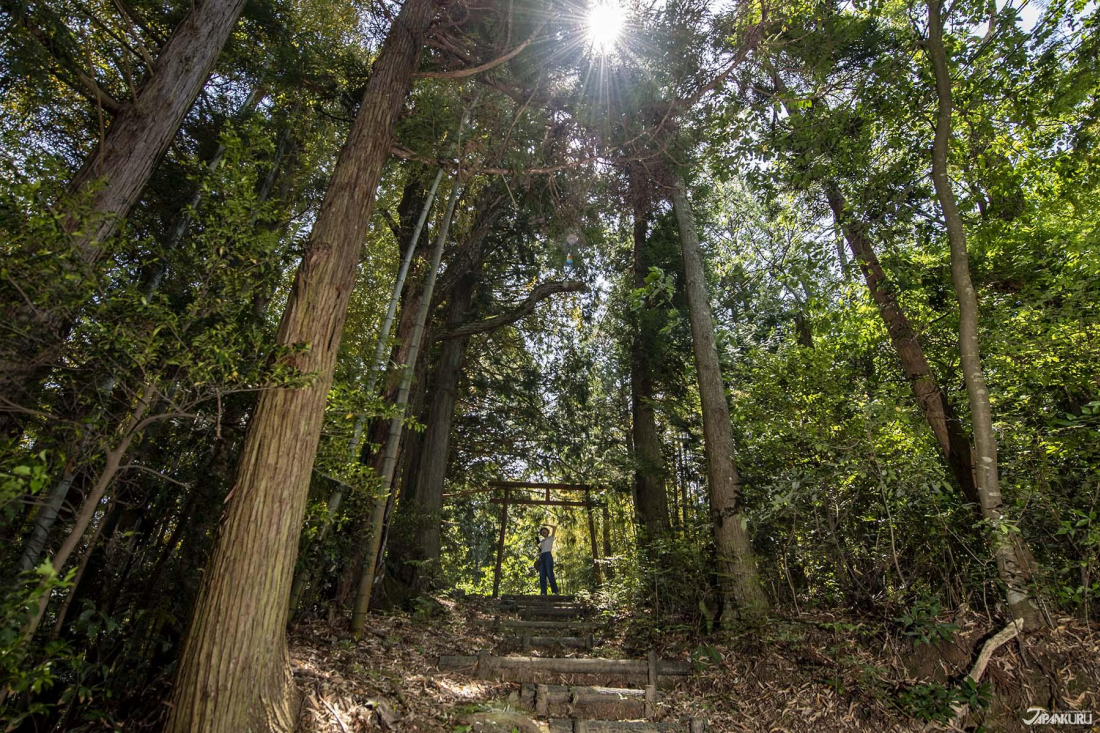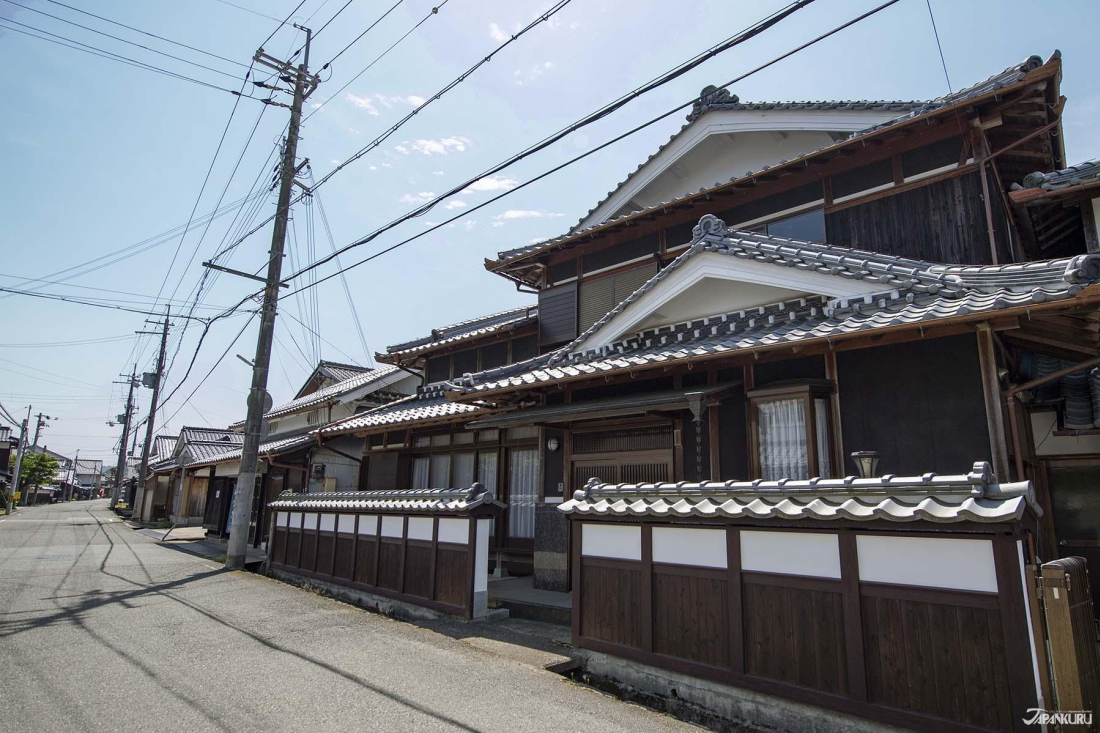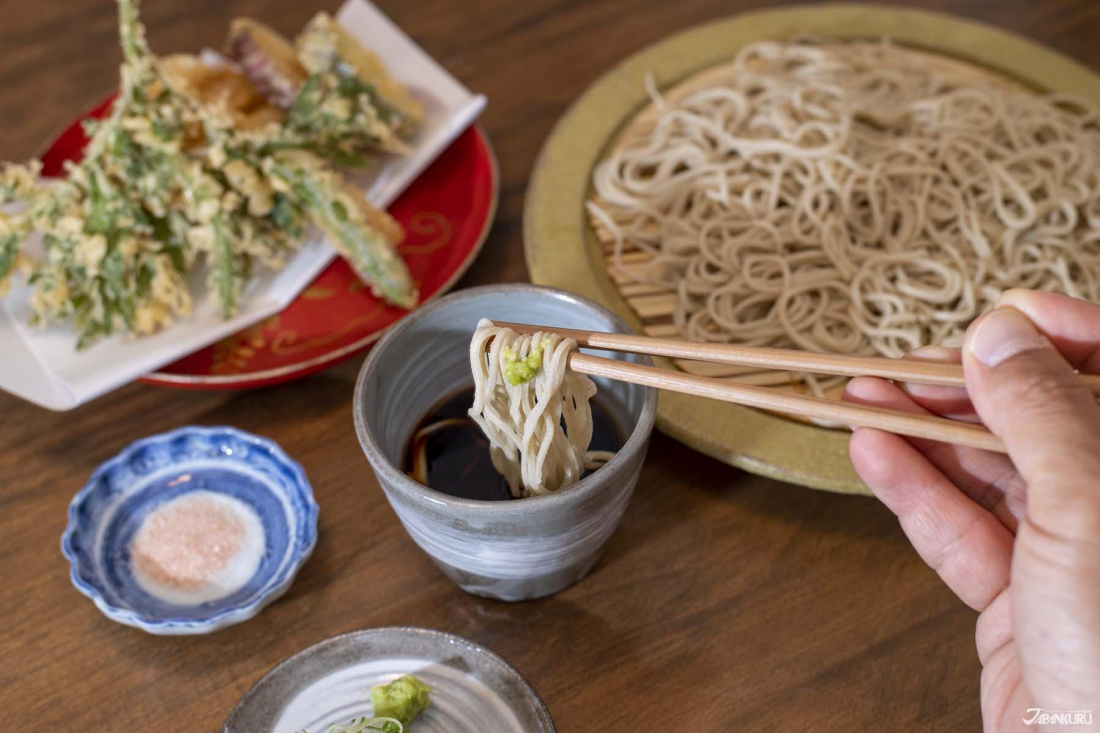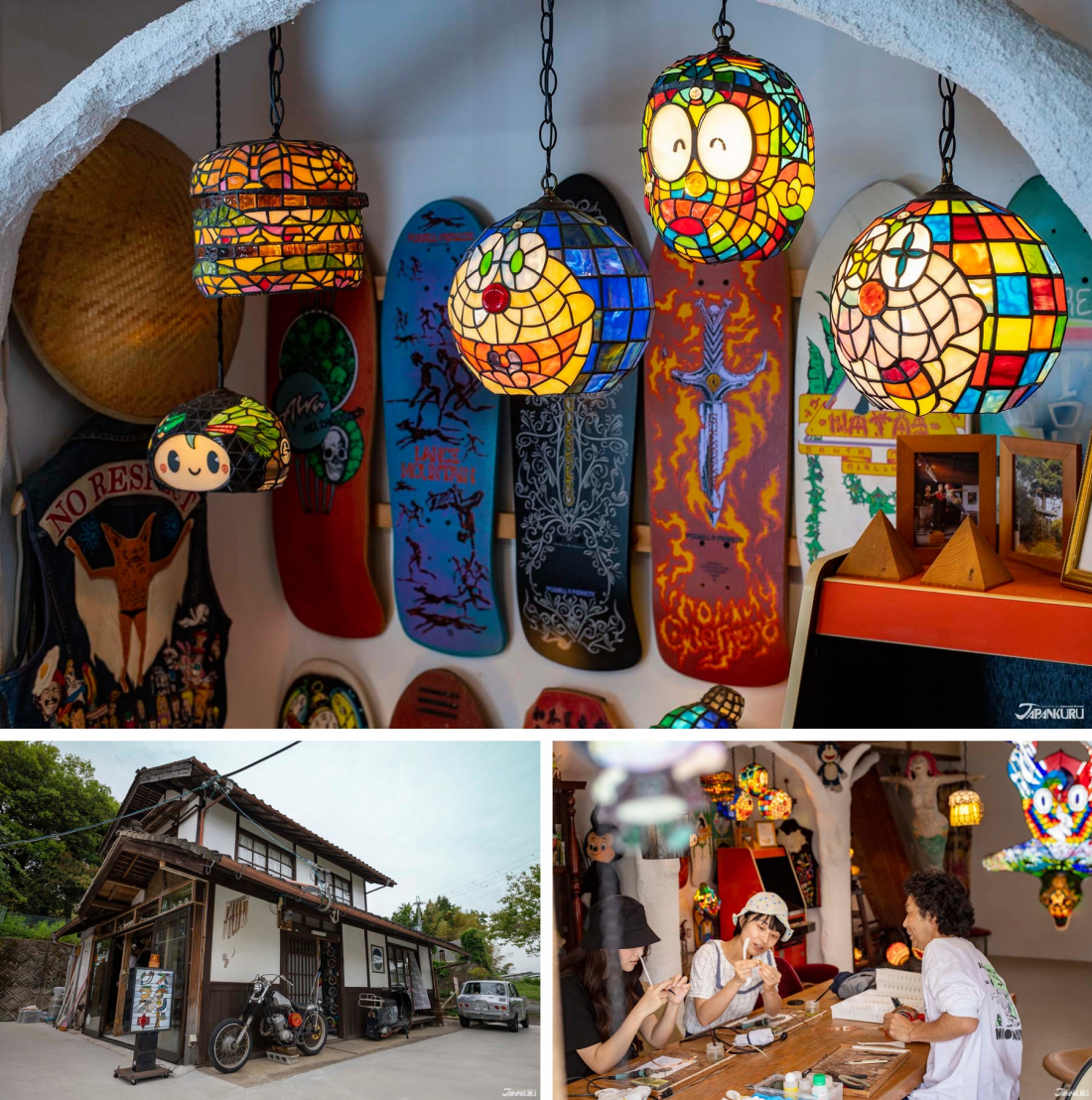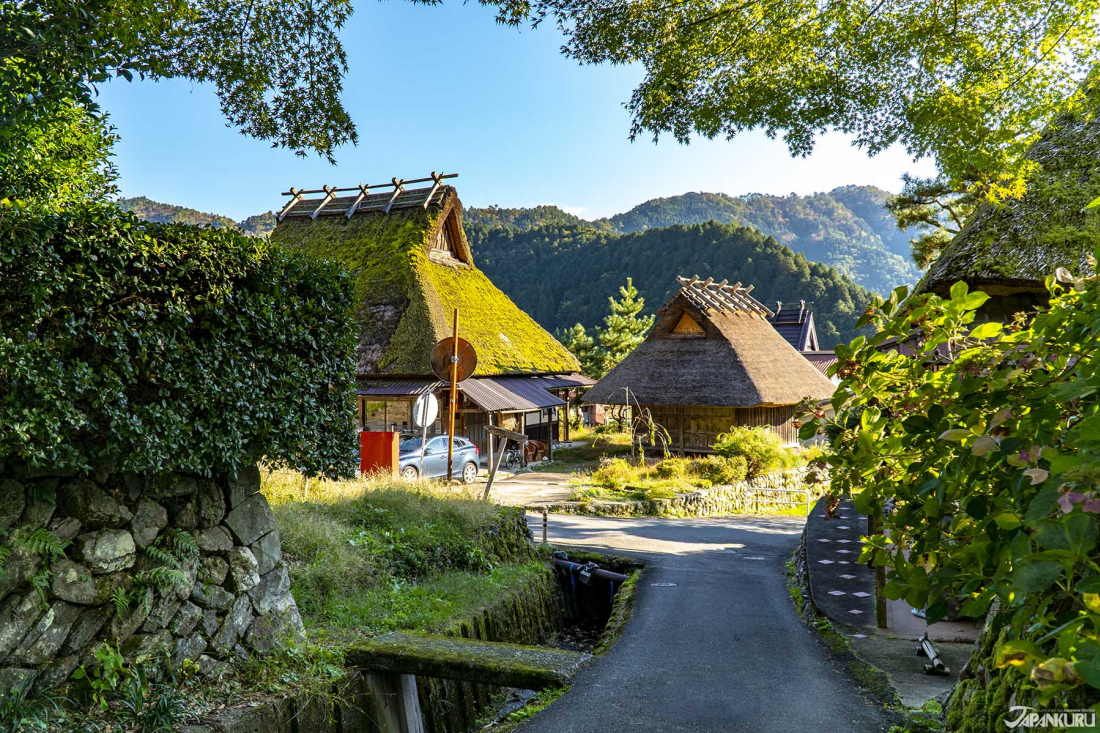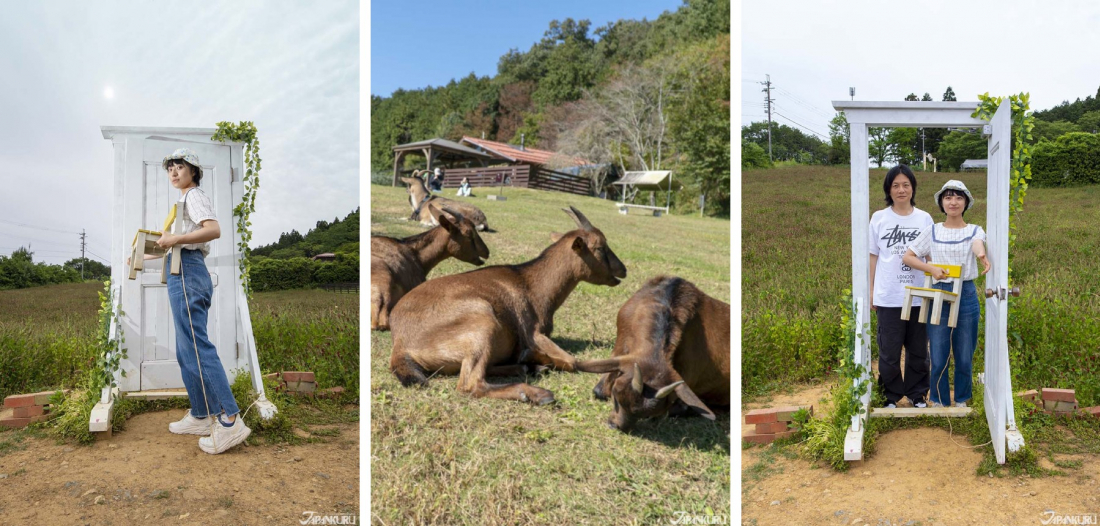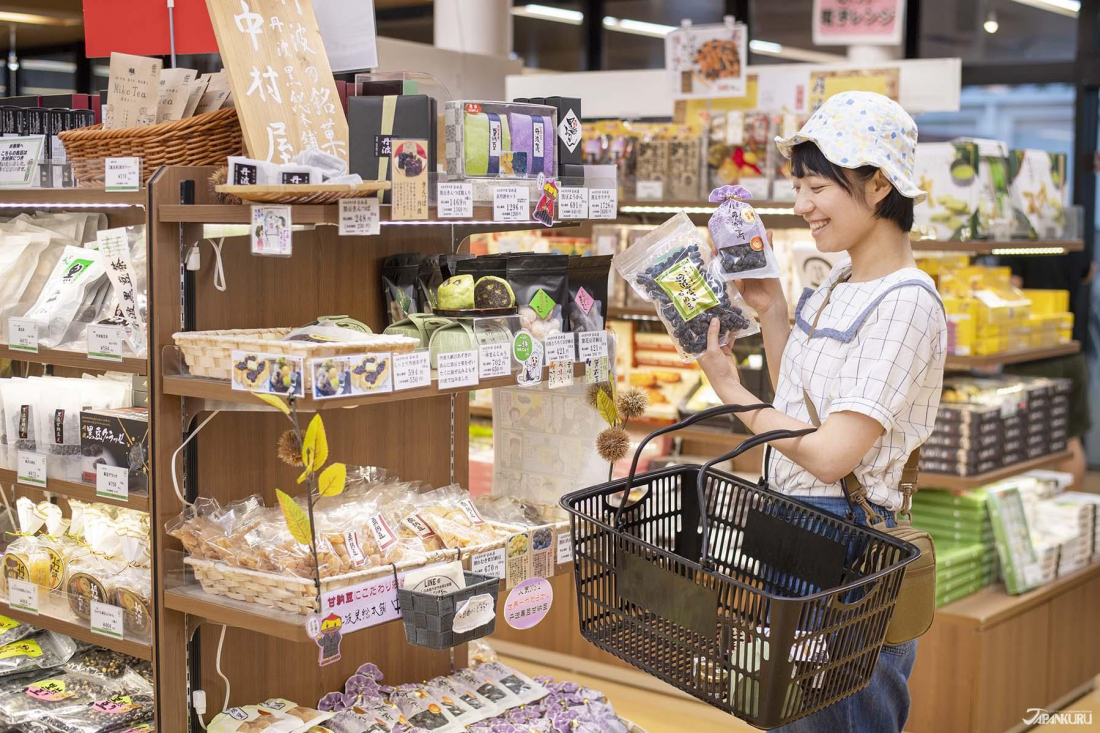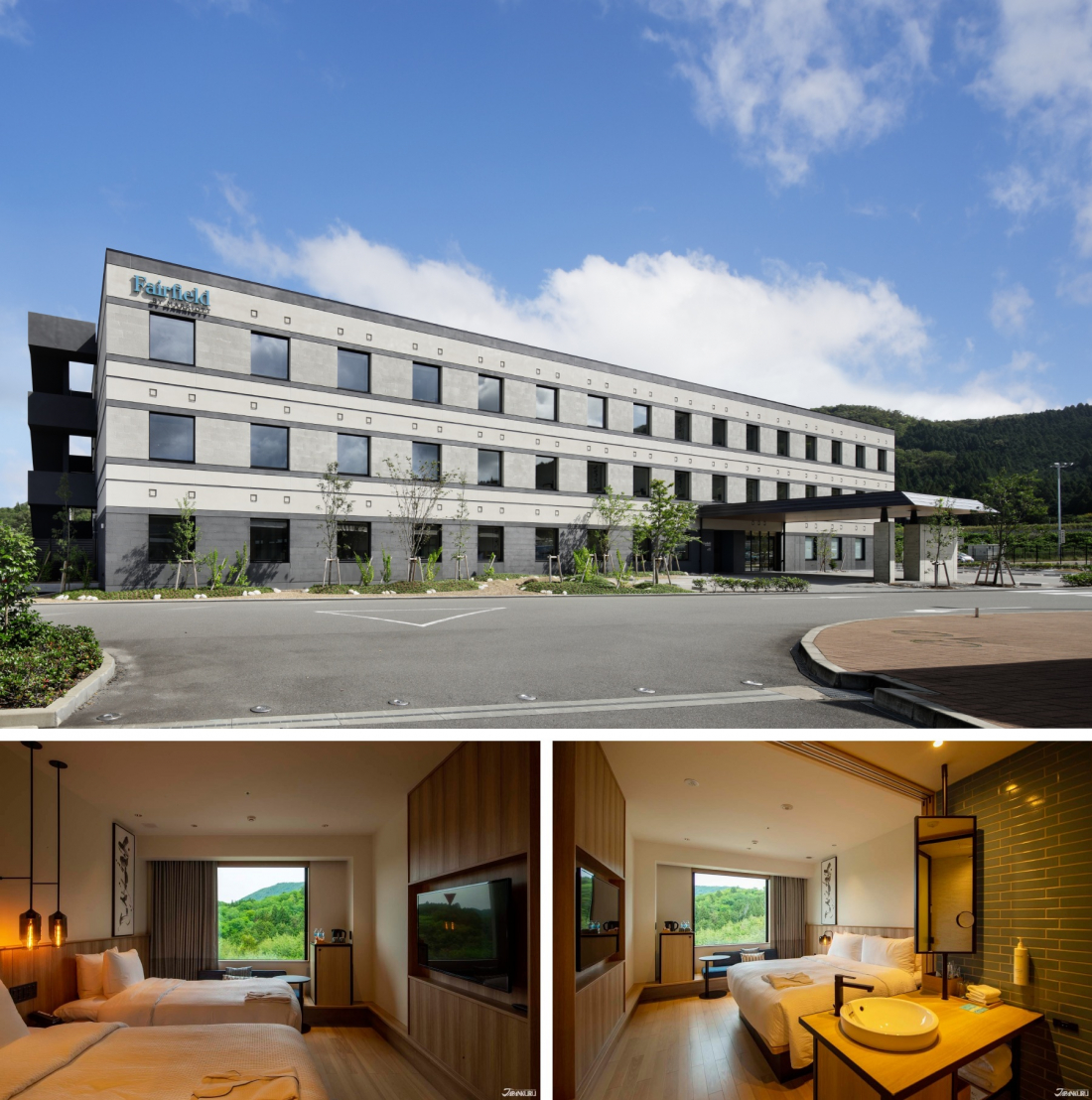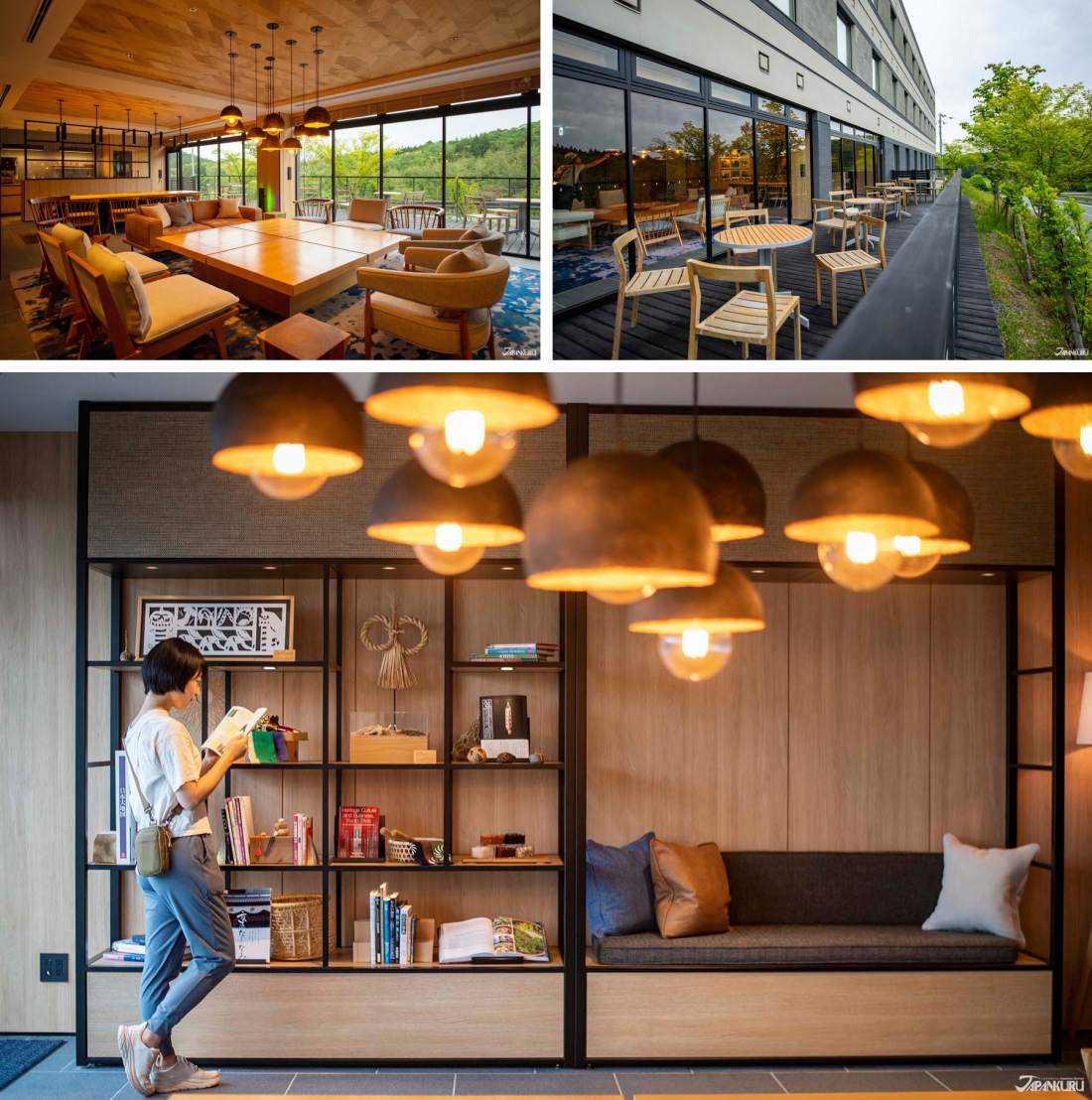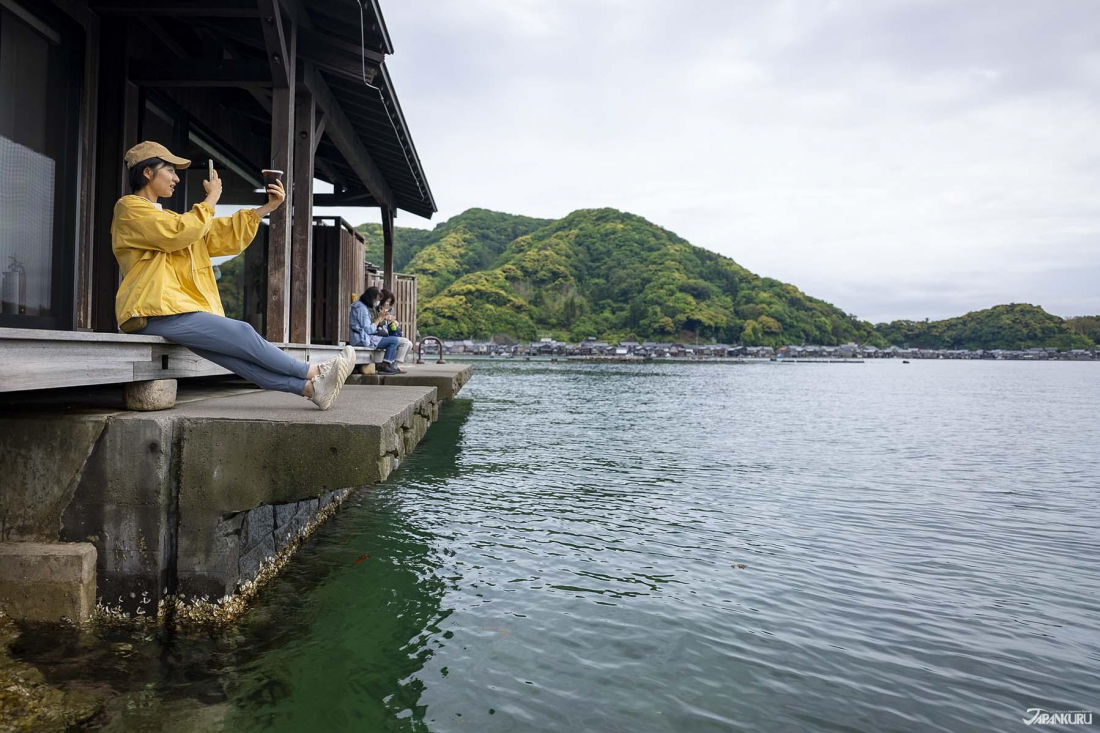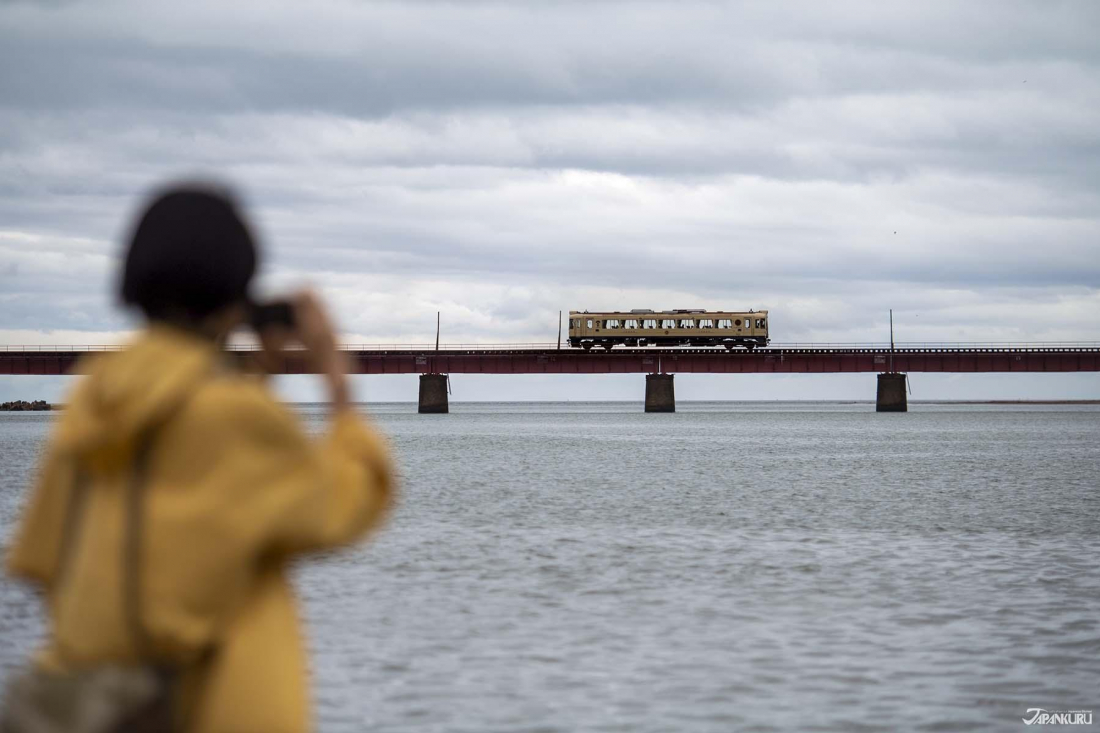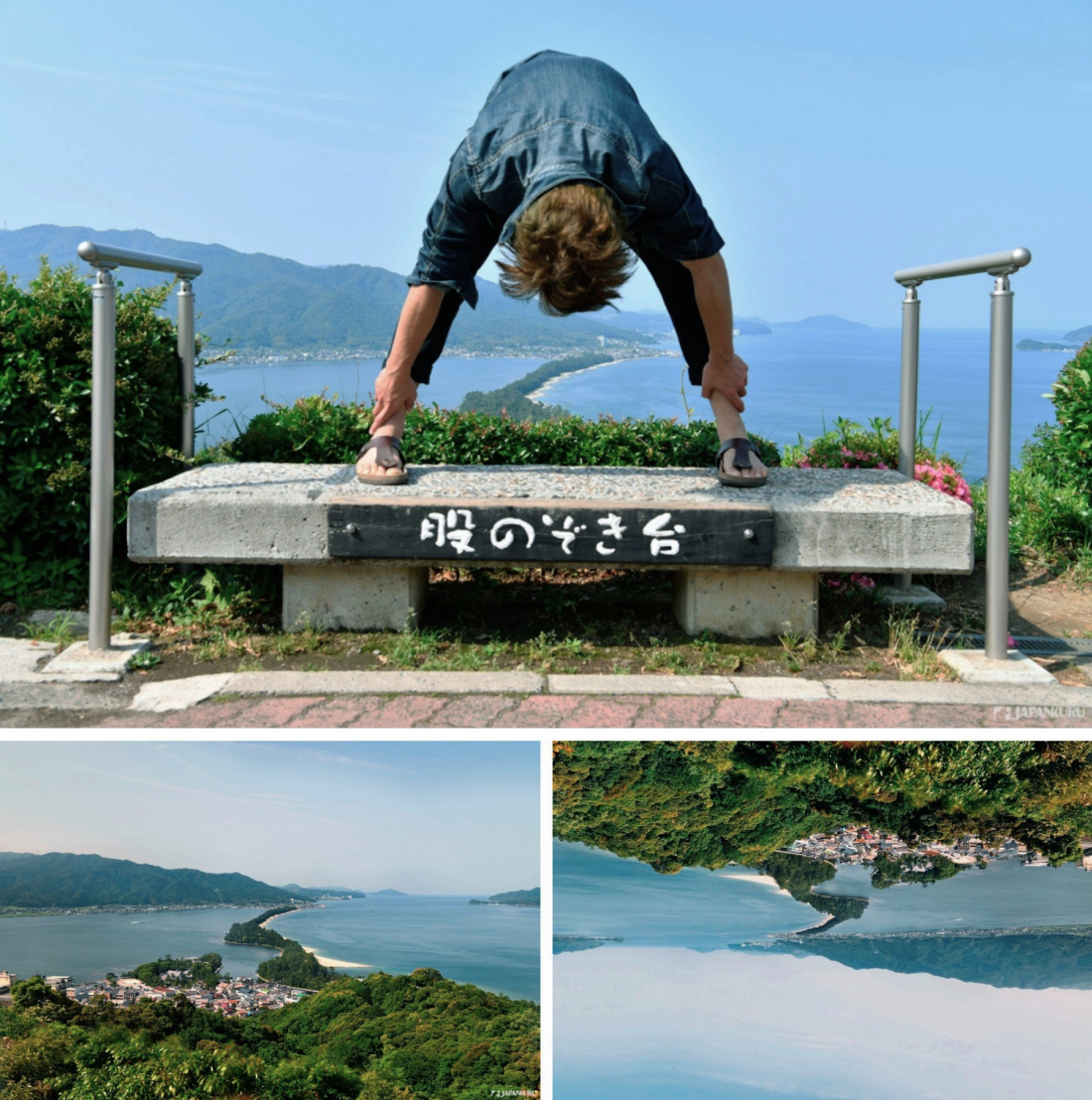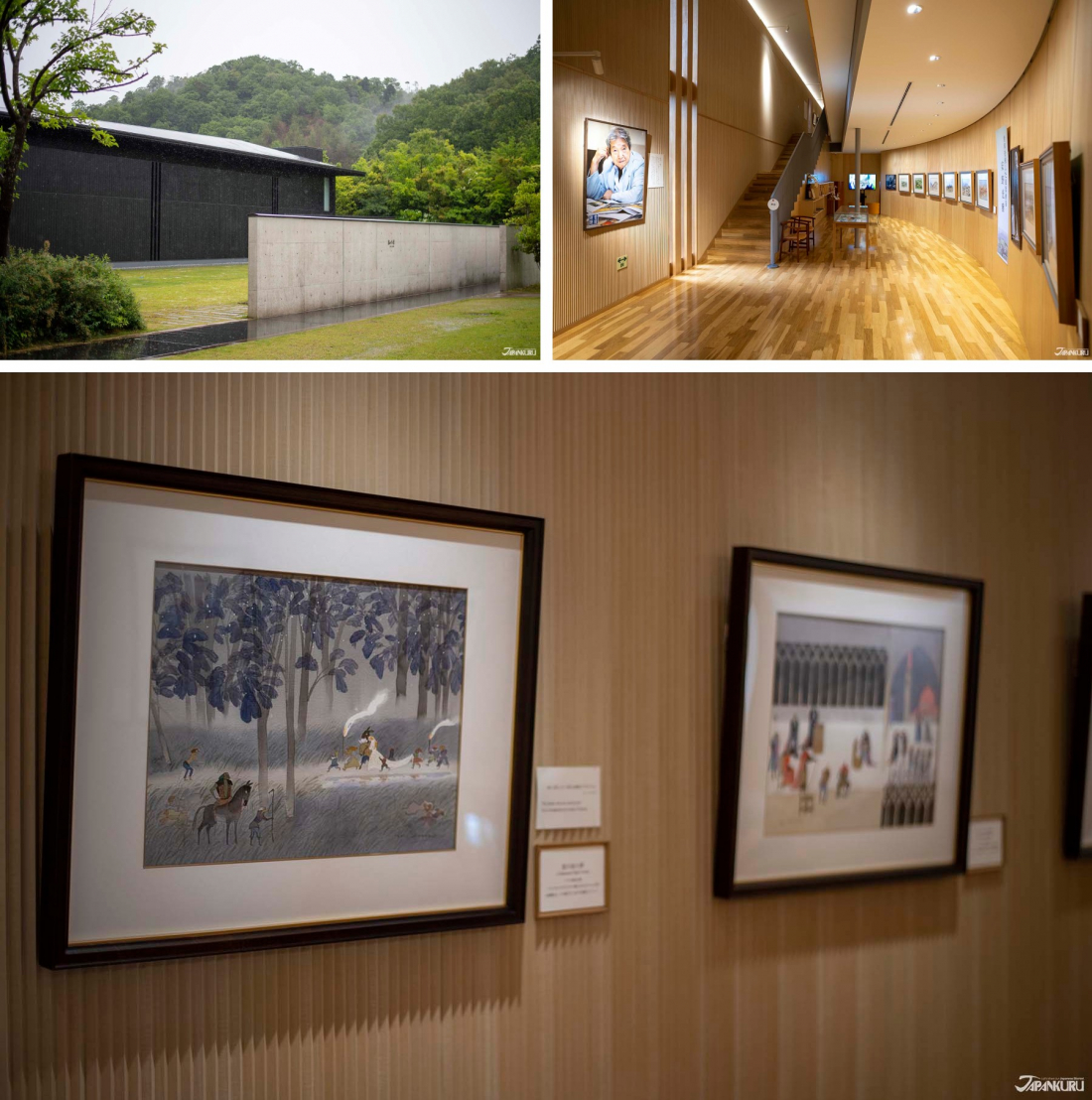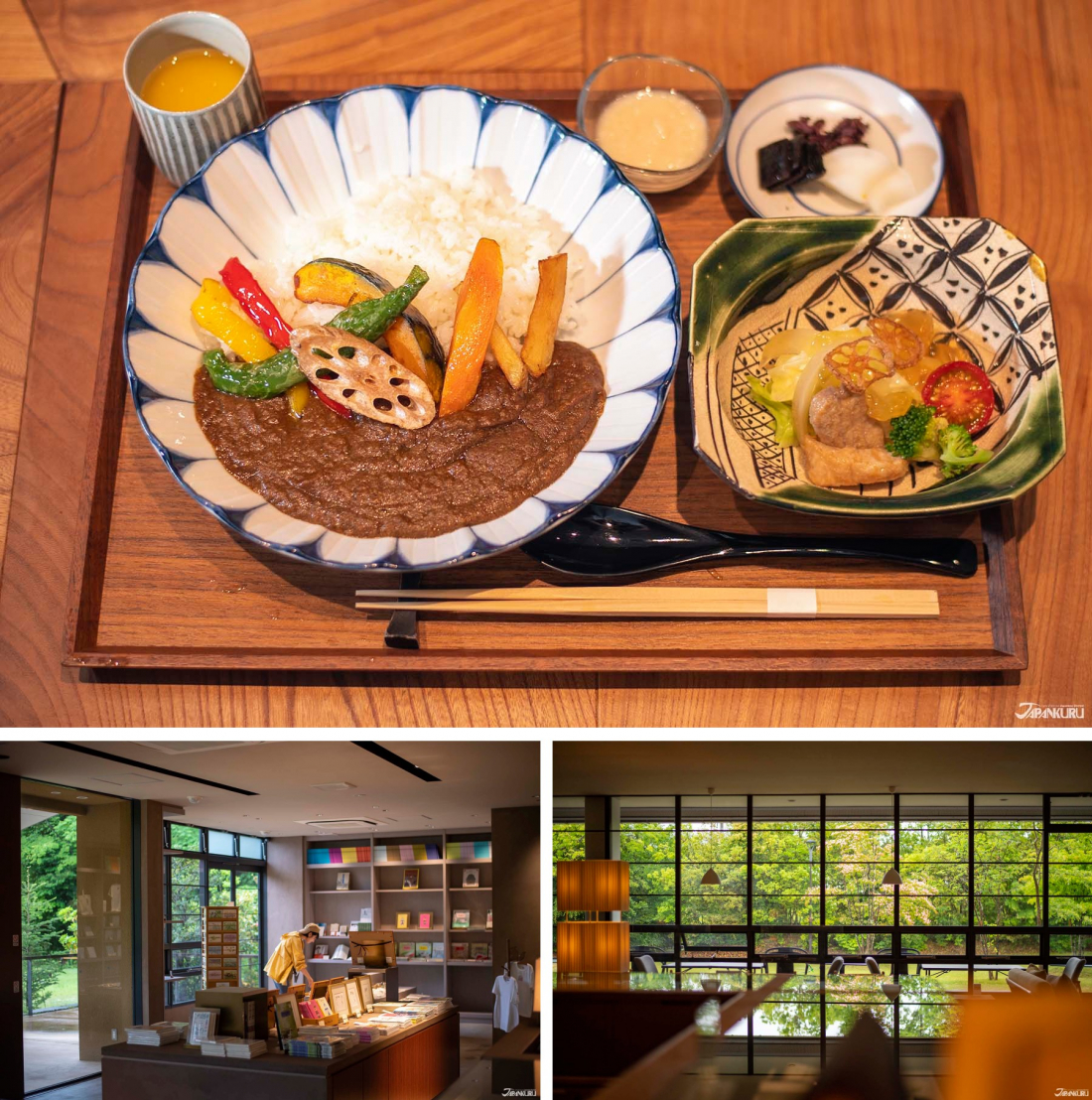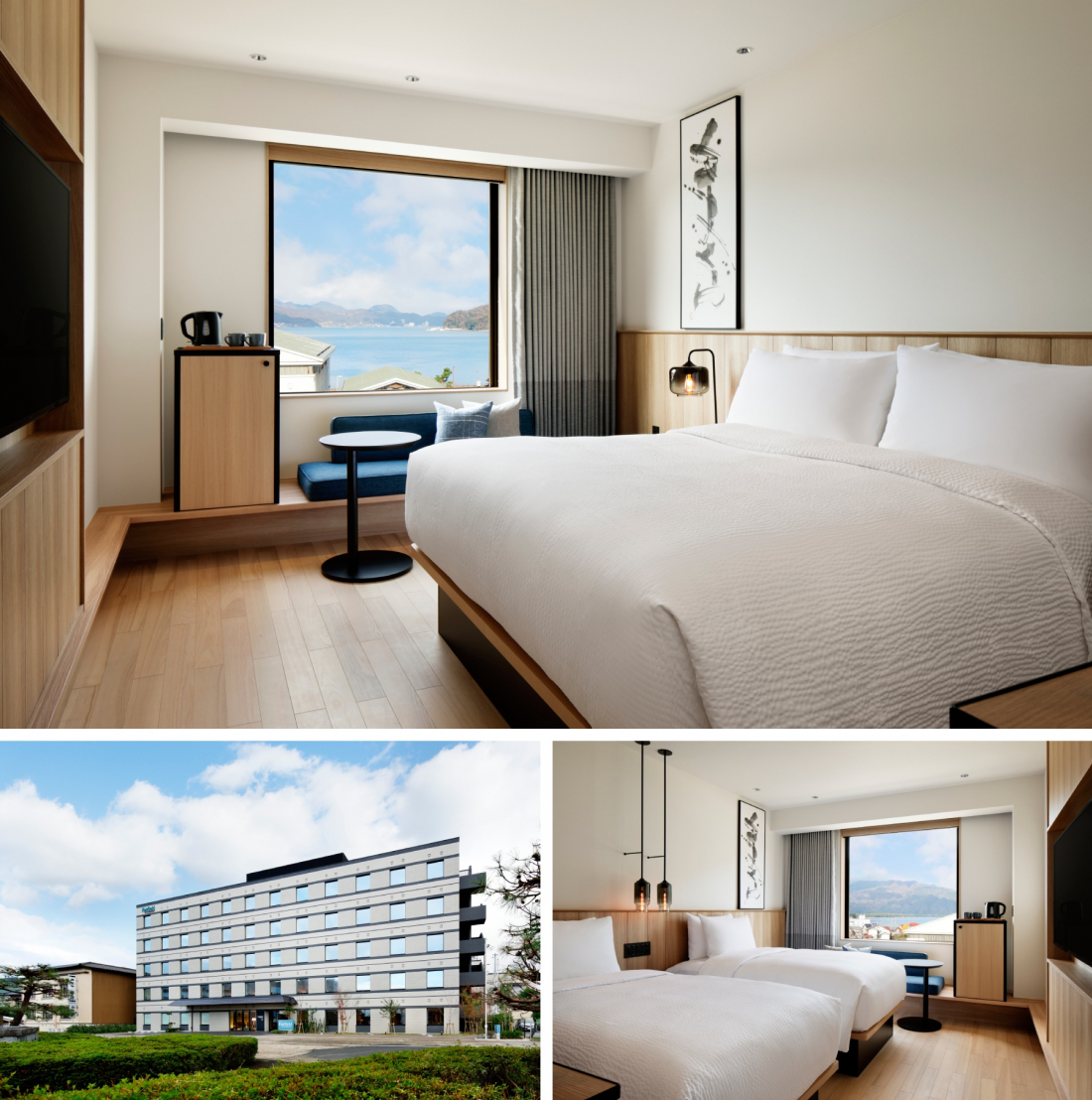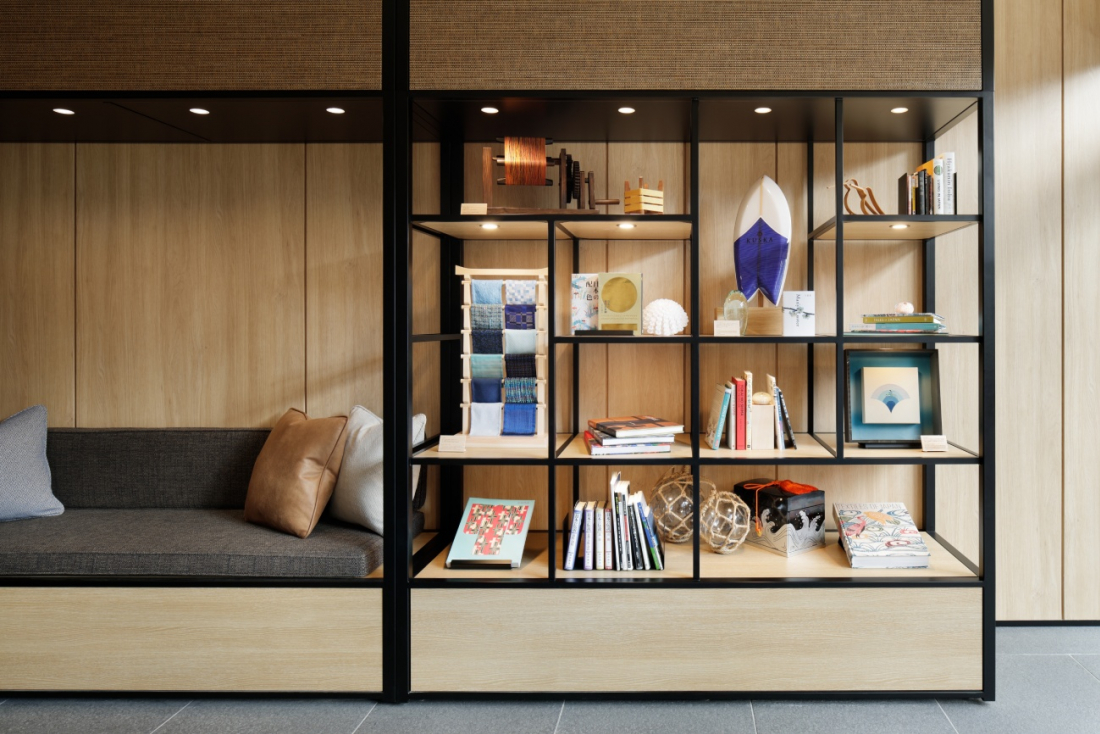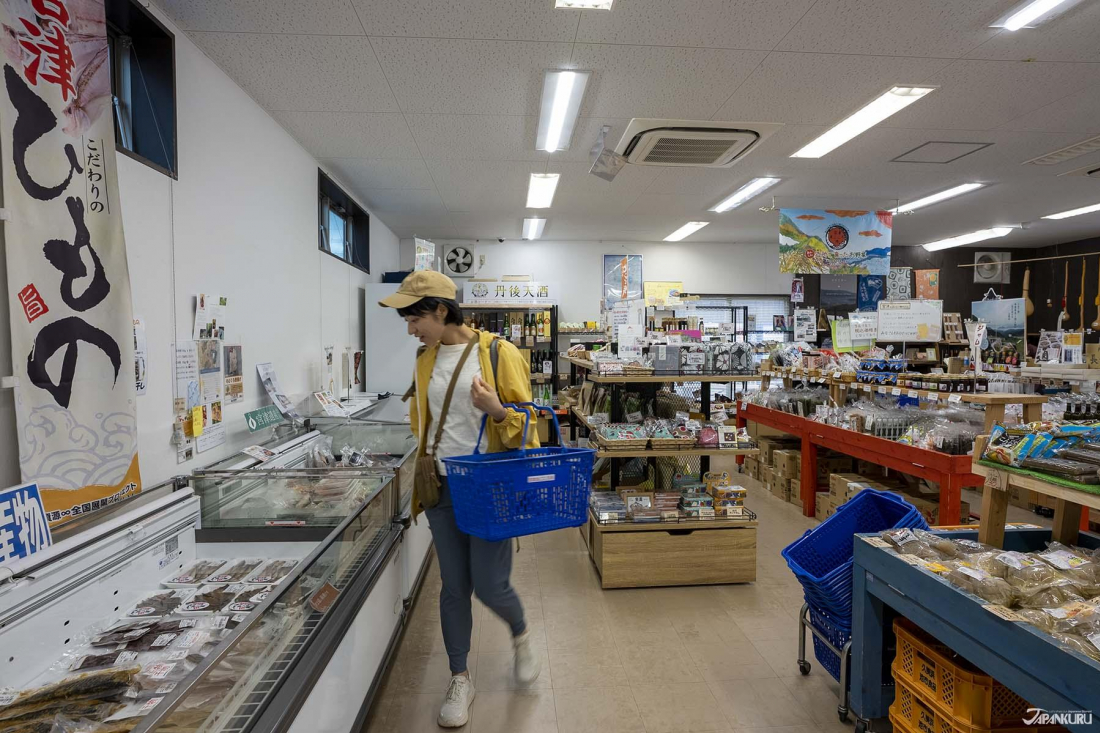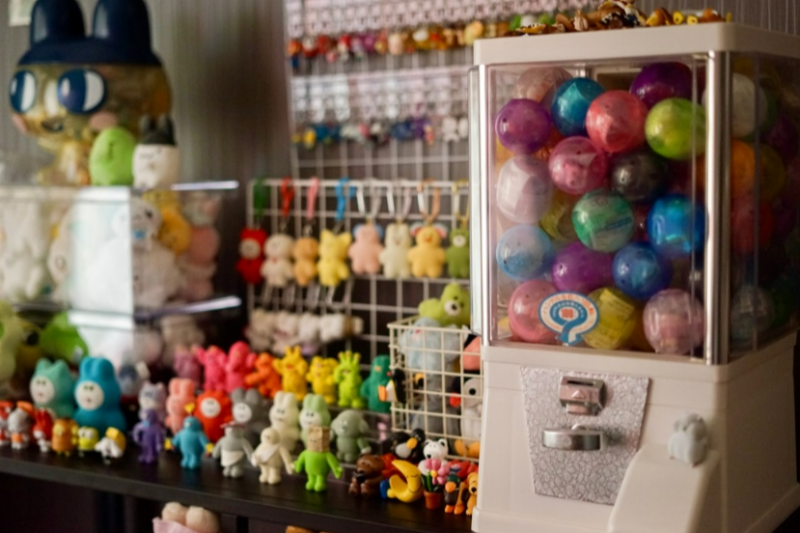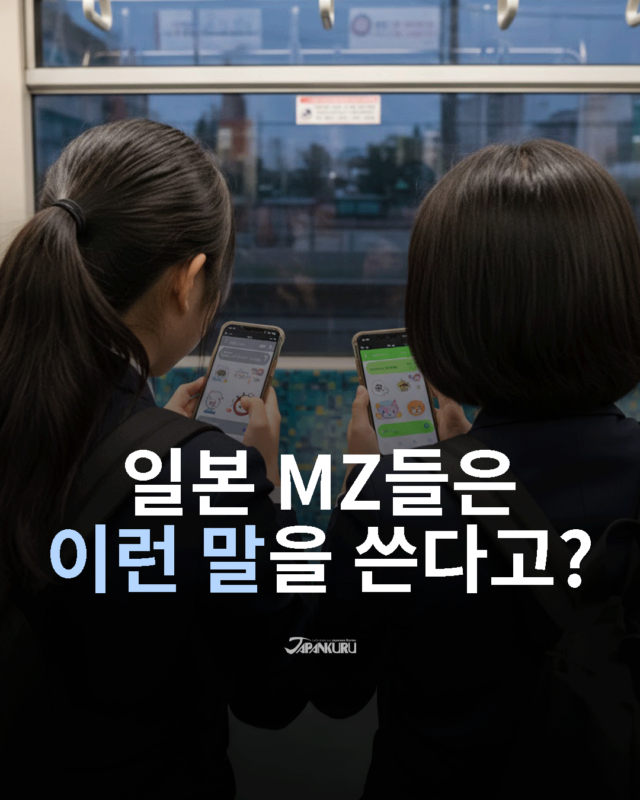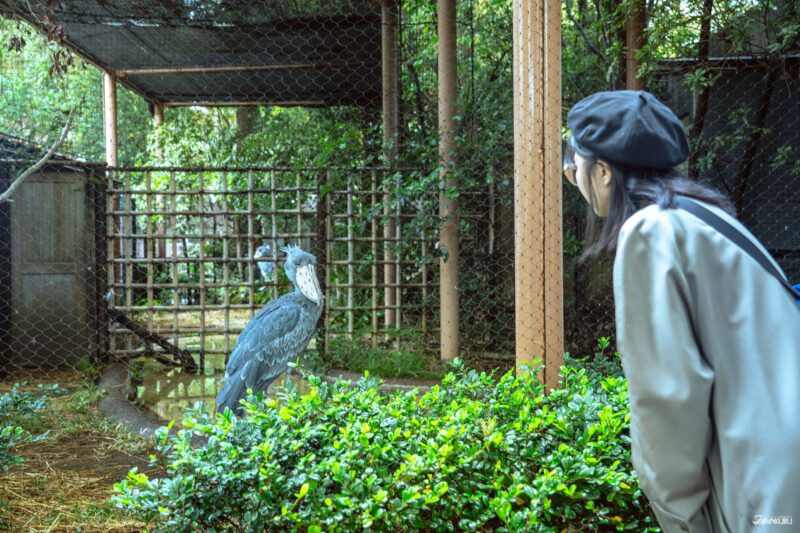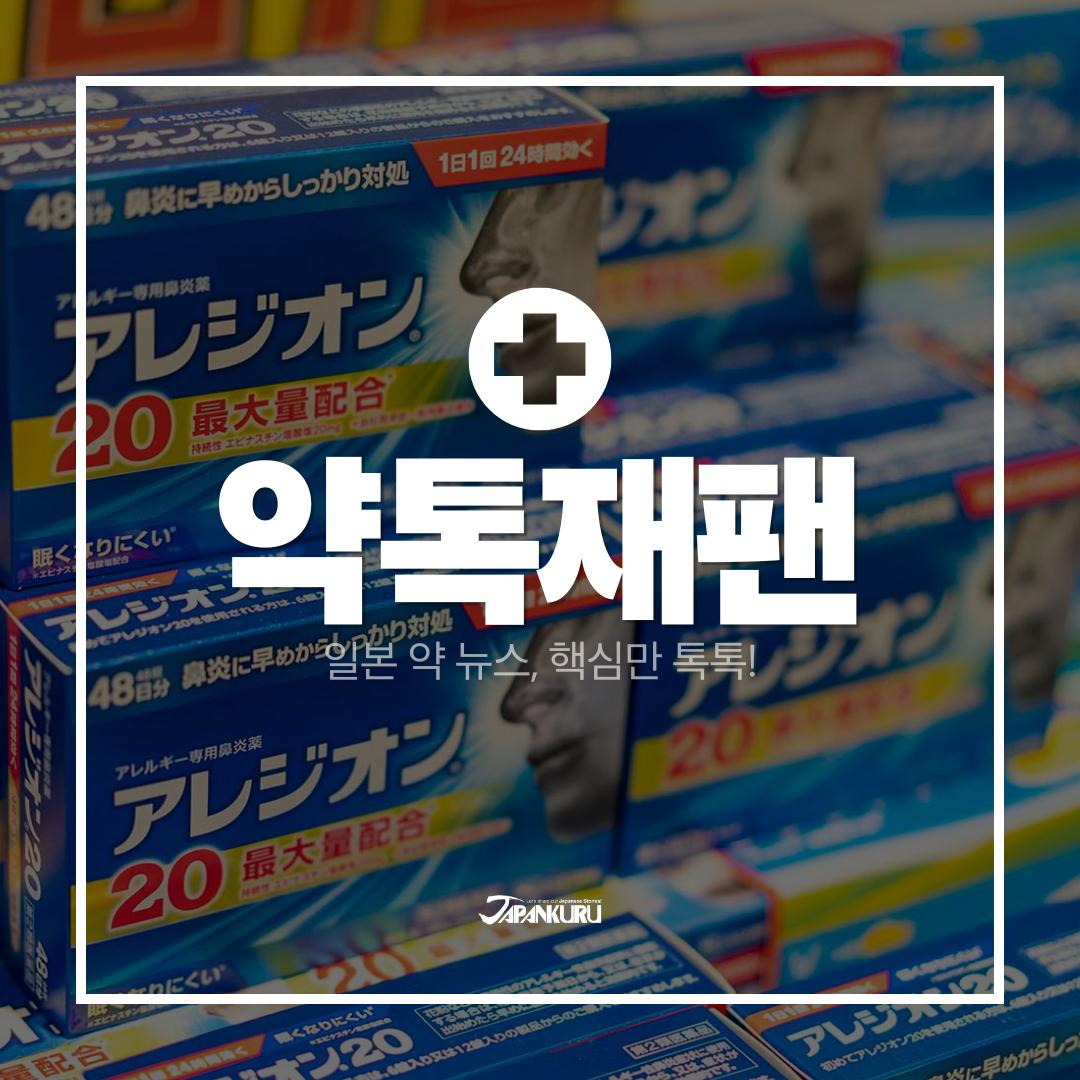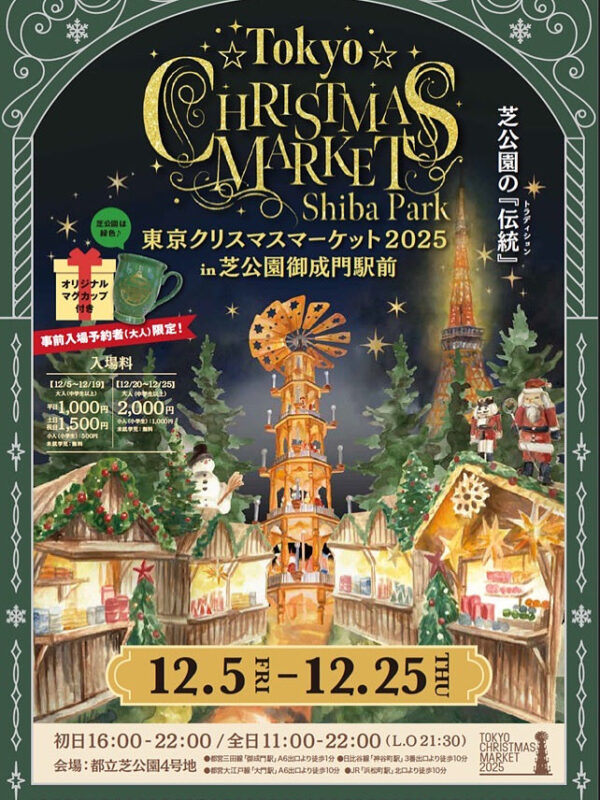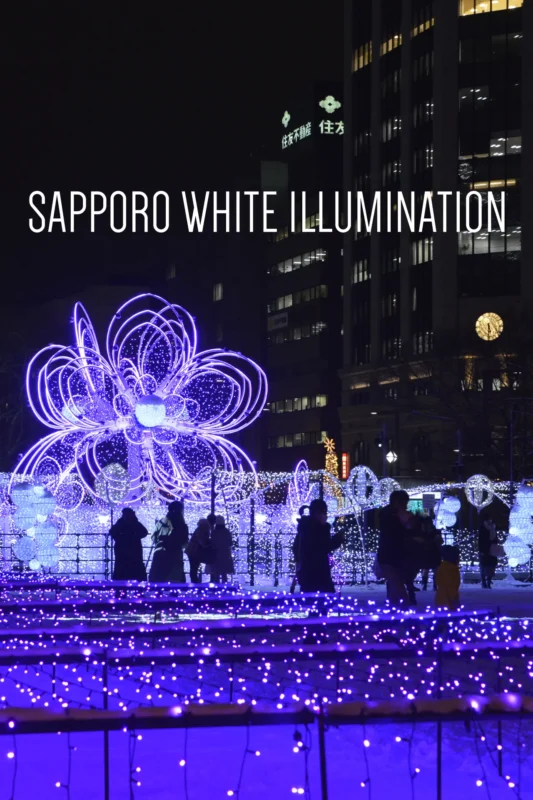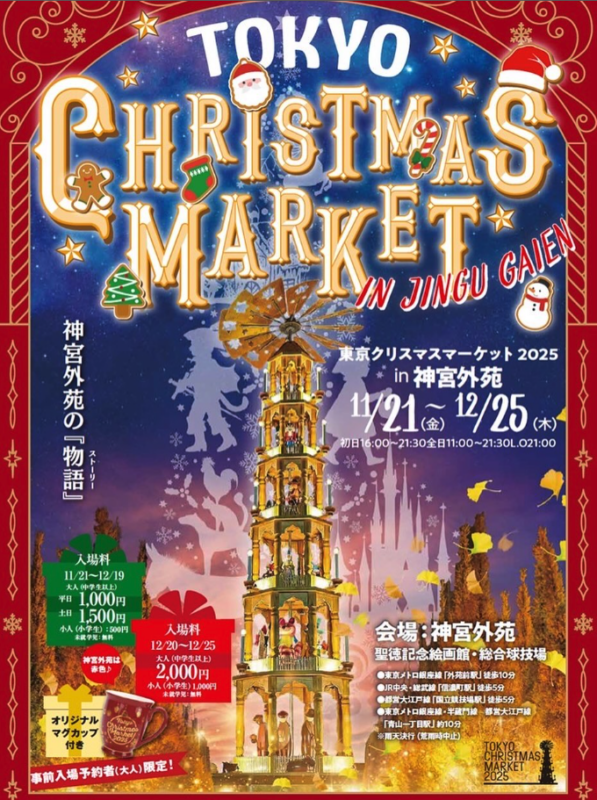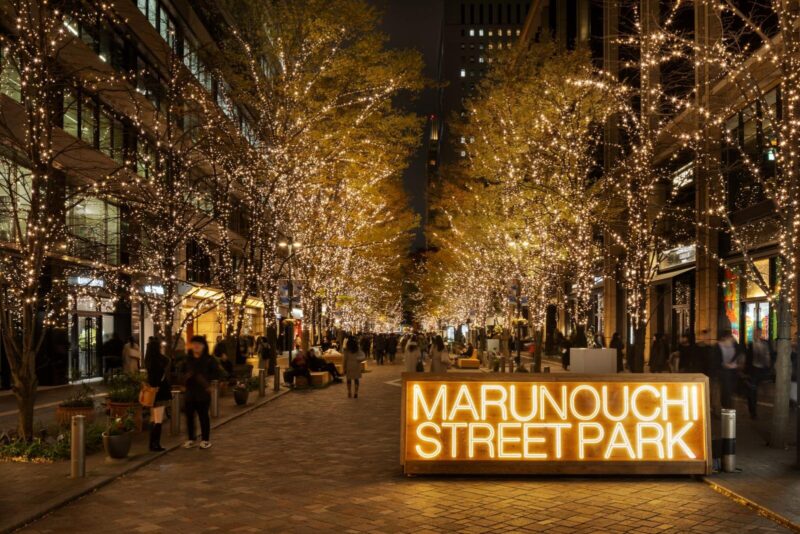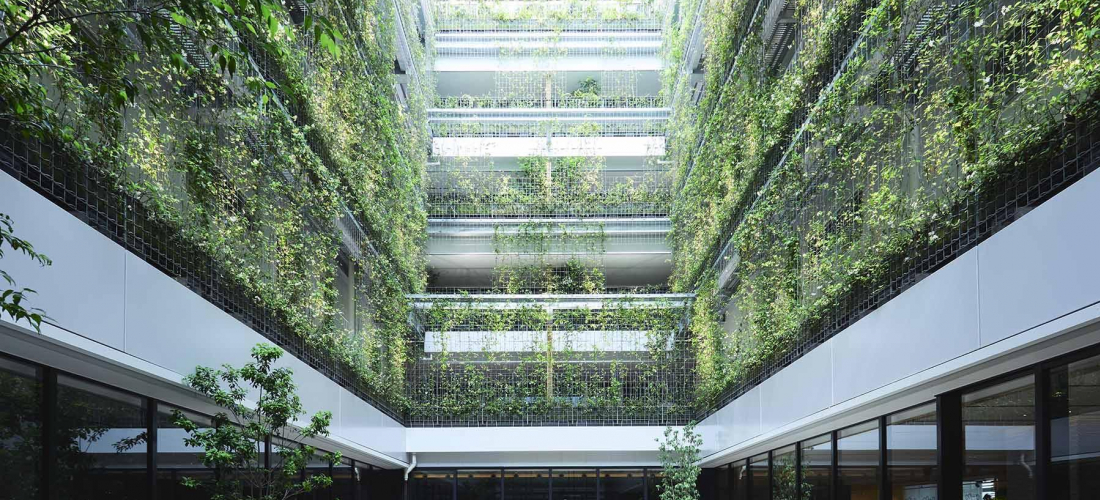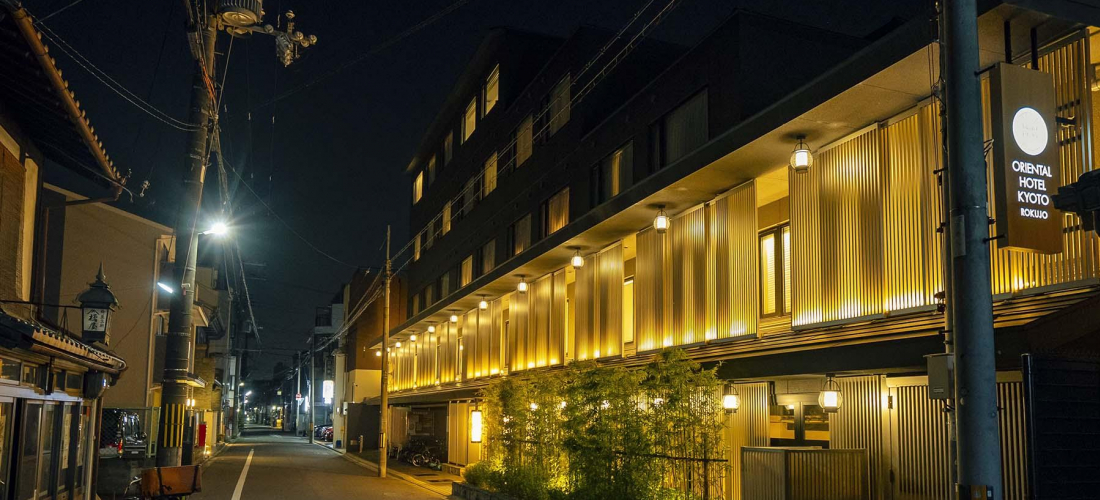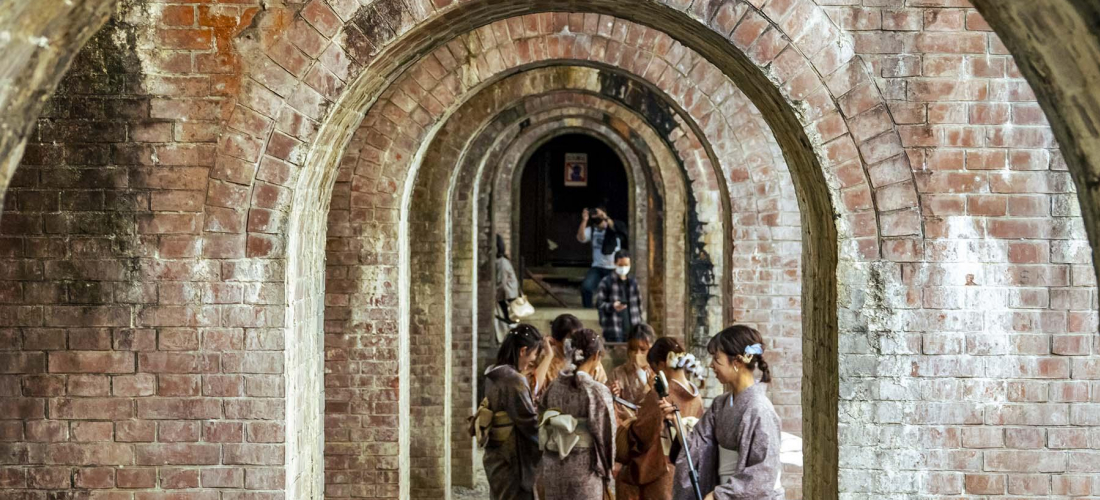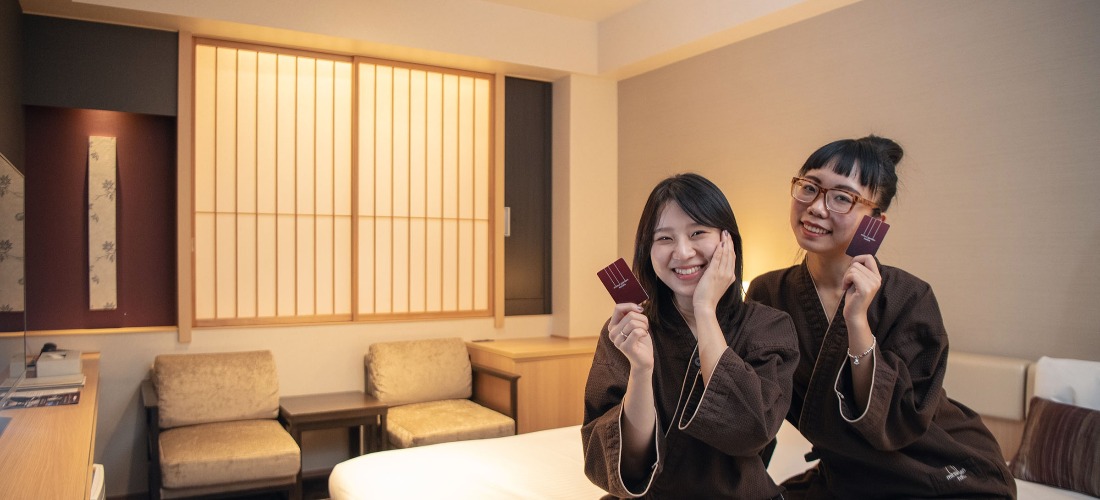CONTENTS
교토의 숨겨진 보석같은 마을을 만나는 드라이브 여행, 로케이션의 편리함과 리조트의 아늑함이 있는 길 위의 호텔과 함께.
로드 트립 – 교토의 로컬을 따라서
교토는 일본의 전통과 역사적 명소, 아름다운 풍경이 가득한 보물창고 같은 도시지만 대부분의 관광객은 교토가 지닌 보물의 극히 일부만을 즐기고 있죠. 실제로 교토의 도심 지역은 이른바 '오버 투어리즘' 문제를 해결해야 할 정도로 엄청난 사람들이 몰려들고 있지만, 외곽의 시골 마을들은 푸른 산과 아름다운 해변으로 이루어져 있음에도 여전히 외국인의 발길이 거의 없다시피 하죠.
거기엔 여러가지 이유가 있겠지만, 교통 편의성 문제가 그 중 하나입니다. 특히 열차 여행으로는 다다르기가 쉽지 않은 산 속 또는 바닷마을의 보석 같은 절경을 만나기 위해서 '렌터카'라는 수단을 선택하는 사람들이 늘어나는 추세인데요, 못 가는 곳이 없는 대도시의 대중 교통 대신, 교토의 국도 길을 따라 자동차로 여행을 하다 보면, 생소한 해변 마을이나 고대의 신사, 일본 3대 절경, 농장 레스토랑 등 지금까지와는 다른 아름다운 자연과 매혹적인 전통, 오래지만 새로운 마을 그리고 최고의 맛이 있는 신세계를 만나게 될 것입니다.
그리고 일본의 국도 곳곳에 마련된 휴게소인 '미치노에키"(道の駅, 길의 역)'을 따라 그 지역의 매력을 살펴볼 수 있는데요, 그 중 일부에는 '페어필드 바이 매리어트(Fairfield by Marriott)' 호텔이 함께 자리잡고 있어 편안한 숙박과 함께 편리한 동선으로 교토의 로컬 지역을 쉽게 둘러볼 수 있습니다.
Day 1: 단바(丹波)의 산과 마을 속으로
지금부터 소개해 드릴 '2박 2일'의 드라이브 여행은 교토시에서 출발하지만 교토의 유명한 관광지는 포함하고 있지 않습니다(교토의 관광지는 여기에서 참고하실 수 있습니다). 시작점을 교토 시내로 설정한 것은 도시의 편리성 때문인데요, 다른 지역으로의 이동이 편하고 렌터가를 구하기도 한결 수월하기 때문이죠. 이번 여행의 진짜 목적인 교토의 로컬 마을을 만나보기 위해 도시를 벗어나 북서쪽에 위치한 단바(丹波)지역의 산 속으로 떠나봅니다.
역사와 예술의 도시로 알려진 교토의 중심부와 달리 단바(혹은 교탄바, 京丹波) 지역은 조용한 시골 분위기를 만끽하기에 충분한 곳입니다. 길가의 작은 신사들은 옛스러움으로 가득하고, 대대로 이어지는 농가의 삶이 있는 이곳에서는 현지의 식재료만으로 만드는 음식들을 맛볼 수 있는데요, 오래도록 간직해 온 정통적인 맛에 대한 지역 주민들의 자부심도 상당합니다. 일본의 시골 하면 일자리를 찾아 대도시로 떠나버린 젊은이들의 부재와 고령화 문제가 가장 먼저 떠오를지도 모릅니다. 하지만 이곳 단바의 주민들에게서는 마을에 대한 자부심과 열정을 몸소 느낄 수 있습니다.
일본의 유명 대도시 여행도 좋지만, 숨겨진 보물과도 같은 경험을 위해서는 단바와 같은 지역으로 떠나보는 것도 일본의 새로운 매력을 발견하기에 좋은 것 같습니다.
후쿠스미의 에도 거리
이번 여행의 테마가 “교토 로드 트립”인 만큼, 대중교통보다 이동이 자유로운 자동차 여행의 장점을 살려서 첫 날부터 교토와 이웃한 효고현까지 발길을 뻗어 역사가 살아있는 작은 도시인 '후쿠스미(福住)'로 떠나 봅니다.
일본의 옛 수도였던 교토와 사사야마 성(篠山城) 사이에 위치하며 에도시대(1603-1868) 사무라이들의 여행길 쉼터 역할을 했던 후쿠스미는 많은 여행자들의 발길이 끊이지 않았다고 합니다. 작고 조용한 현재의 마을 모습을 보면 과거 많은 인파로 북적였단는 게 거짓말처럼 느껴지지만 오래된 집들과 역사를 간직한 이정표들이 예전의 모습들을 상상케 합니다.
가장 먼저 가볼 곳은 조용한 마을의 웅장한 경치가 펼쳐지는 곳입니다.
800년 역사를 가진 33m의 거대한 삼나무(야스다노 오오스기, 安田の大杉)로 유명한 기후네 신사(貴船神社)입니다. 이 삼나무는 1970년에 효고현의 천연기념물로 지정되었으며 다른 나무들과의 거리가 비교적 떨어져 있음에도 불구하고 압도적인 크기 때문에 멀리서 보면 하나의 숲처럼 보인다고 해서 '진시치의 숲(甚七の森)' 이라는 이름으로 불리고 있습니다.
다음으로 향할 곳은 '산바야 히구치(さんば屋ひぐち)'.
이곳은 400년 역사의 전통적인 일본식 건축물의 전형으로, 원래는 아이를 낳는 조산원의 역할을 했지만 현재는 마을 회관의 역할을 하고 있습니다. 여기서 더 걸어 가다 보면 지금은 잔해만 남은 후쿠스미역을 둘러볼 수 있습니다. 철도 노선 '사사야마선'의 종착역이었던 후쿠스미역은 20세기 중반 지역 광산 이동에 있어 중요한 거점 역할을 했었지만 이제는 오래된 선로와 표지판만이 남아 있습니다.
열심히 걸었으니 커피와 함께 잠시 쉬어 갑니다.
후쿠스미의 모닝 커피를 즐기기에 딱인 '매그넘 커피(Magnum Coffee)'는 가게에서 로스팅한 유기농 원두로 내린 커피를 즐길 수 있습니다. 레트로한 분위기의 인테리어와 더불어 화창한 날엔 햇볕이 잘 드는 야외 테라스석도 준비되어 있으니 여유로운 휴식시간을 가지기에 좋습니다. 카페 오른편에는 평평한 논밭 사이로 우뚝 솟은, 지브리 영화 '바람 계곡의 나우시카'에 나오는 '오무'를 닮은 후나오카 산(船岡山)이 자리하고 있습니다. 산 꼭대기로 향하는 돌계단을 오르다 보면 만나게 되는 붉은 도리이로 가득한 '마루야마 이나리 신사(丸山稲荷神社)' 또한 지브리 영화 속 세계에 들어온 것 같은 착각을 불러 일으킵니다.
후쿠스미 지구 (福住地区)
산책 루트 구글맵
공식 웹사이트(jp)
Magnum Coffee
효고현 단바 시노야마시 후쿠스미 317
영업 시간: 평일 10:00 – 18:00 | 주말 8:00 – 18:00
공식 웹사이트(jp)
점심은 소바 @ 웰컴 우에노 모토시로
“단바 소바(메밀국수)”를 먹기 위해 교토로 다시 돌아가 볼까요?
교토에서 단바 소바를 먹을 수 있는 “웰컴 우에노 모토시로(ウェルカム上野もとしろ)”는 가게 자리에 원래 있었던 옛 성의 이름을 따서 지어졌다고 합니다. 이곳의 특징은 한 쪽 벽면이 통창으로 이루어져 있다는 것인데요, 창문 가득 들어오는 햇빛과 함께 멋진 풍경 속에서 꿈같은 식사를 즐길 수 있습니다. 단바 소바를 더욱 맛있게 즐기기 위해서는 튀김(텐푸라)가 필수인데요, 웰컴 우에노 모토시로에서는 마을 농부들이 수확한 제철 채소의 튀김들이 제공됩니다. 따뜻한 날씨 덕분에 잘 자란다는 신선한 메밀가루도 맛의 비결로 향긋한 메밀의 참맛을 느낄 수 있답니다.
웰컴 우에노 모토시로( ウェルカム上野もとしろ)
교토부 후나이군 쿄탄바초 우에노 미나미가키우치 23-1
영업 시간: 11:00 – 16:00 (화요일, 수요일 휴무)
공식 홈페이지(jp)
구(旧)시츠미 초등학교
어린 시절 향수를 불러 일으키는 장소인 초등학교 건물을 활용한 '구 시츠미 초등학교'는 2011년 폐교 후 마을 사람들을 위한 새로운 공간으로 재탄생하게 되었습니다. 오래된 교실은 지역 사람들이 운영하는 다양한 가게들로 그 빈자리를 채우게 되었습니다. 카페, 이탈리아 식당, 아이들을 위한 그림책 가게, 오카키(おかき, 일본식 전통 쌀과자)와 같은 가게들로 말이죠. 특히나 이 곳은 애니메이션 팬들이 일본의 진짜 학교를 직접 둘러 볼 수 있는 기회를 제공하는데요, 실제 학교에서는 하기 힘든 코스프레 촬영 장소로도 아주 좋으니 한 번 둘러보고 독특한 기념 사진도 남겨 봅시다.
구 시츠미 초등학교(旧質実小学校)
교토 후나이구 교탄바 시츠미 우에노-43
공식 홈페이지(jp)
감각적인 스테인드글라스 공예의 세계 – 자폰 랜드
주로 교회의 창문이나 조명으로 많이 사용되는 스테인드글라스.
이곳에서는 그 이상을 보여 주는 아주아주 다양한 스테인드글라스 세계를 만나볼 수 있습니다.
자폰랜드(Jahpon Land)는 경력 20년 이상의 스테인드글라스 장인들이 운영하는 가게로, 우리에게도 친숙한 마리오, 도라에몽과 같은 캐릭터를 주제로 한 작품들도 다양하게 존재합니다. 작품 구매 뿐만 아니라 방문객들이 직접 작품을 만들어 보는 체험 프로그램도 즐길 수 있는데요, 약 1시간에서 4시간 동안 진행되며 누구나 어렵지 않게 스테인드글라스 작품을 완성할 수 있습니다.
또한 주문 제작도 가능하며, 가장 인기 상품은 고양이 모양의 램프(100,000엔 이상)으로 원하는 문구를 새겨 주기도 합니다.
자폰 랜드(JAHPON LAND)
교토 후나이구 교탄바 히노키야마 89 하시즈메
공식 홈페이지
(스테인드글라스 만들기 체험은 공식 홈페이지에서 문의)
미야마의 전통 초가집 마을
미야마의 전통 초가집 마을 '가야부키노사토(かやぶきの里)'는 이번 여행 루트에서 조금 돌아서 가는 위치에 있지만, 수세기 전 교토의 모습을 눈에 담고 싶다면 꼭 방문해야 하는 장소입니다. 이곳의 오래된 초가집들은 지금도 실제로 현지 주민들이 살고 있다는 점이 놀라운데요, 전문적으로 보존되어 현재까지 옛 모습을 간직하고 있는 건축물들 덕분에 마을 전체가 관광지로 이름을 알리게 되었으며 산과 들의 환상적인 풍경은 여행객들에게 특별한 추억을 선사합니다.
미야마의 명물인 소프트 아이스크림과 함께 즐기는 교토의 진짜 자연을 즐겨보세요.
미야마 – 카야부키노사토(美山かやぶきの里)
교토 난탄 미야마초키타
공식 홈페이지
‘스즈메’가 될 수 있는 아야베 후레아이 목장
오늘의 마지막 코스인 '아야베 후레아이 목장'에는 지역의 특산 식재료로 요리하는 레스토랑이 있습니다.
푸르른 초원이 펼쳐진 목장에서 사슴 고기로 만든 스튜와 같은 교토의 '지비에(Gibier) 요리를 맛볼 수 있는 곳이기도 하며, 최근 설치된 어느 조형물 덕분에 요즘에는 인기 애니메인션 영화 '스즈메의 문단속'의 주인공이 되어볼 수 있는 곳으로도 유명해졌답니다. 영화 속에 나오는 '문'과 함께 또다른 등장인물인 '소타'를 상징하는 의자도 놓여 있는 리얼리티 가득한 이곳에서 영화 포스터 인증샷 챌린지와 함께 미미즈를 막는 주인공 스즈메가 되어봅시다.
아야베 후레아이 목장(綾部ふれあい牧場)
교토 아야베시 이덴초 히노키마에 81
공식 홈페이지
저녁과 기념품 쇼핑 @ 미치노에키 아지무노사토
한 나절의 단바 지역 여행을 마치고 돌아가는 길… 빼놓을 수 없는 일정인 쇼핑과 디너가 아직 남았네요.
이번 여행에서 처음으로 방문하게 되는 미치노에키인 '아지무노사토(道の駅 京丹波 味夢の里)'에서는 다양한 기념품을 판매하고 있는데요, 일본 전통 과자뿐만 아니라 단바의 메밀, 견과류, 버섯, 유제품, 검은 콩 등 유명한 지역 특산물을 한번에 만나볼 수 있는 것이 특징이죠. 구운 검은 콩과 밤을 아낌없이 사용한 일본식 전통 도라야키는 이곳의 가장 인기있는 상품이랍니다.
식당 '본치(Bonchi)'에서는 단바 스타일의 저녁을 맛볼 수 있습니다. 대부분의 메뉴들은 현지 식재료를 사용해서 만들어지며 단바산의 운치 있는 풍경을 배경으로 식사를 즐길 수 있습니다. 단바의 특산물로 유명한 검은콩은 거의 모든 메뉴에서 만나볼 수 있으며 옵션으로 검은콩 메뉴를 추가하는 것도 가능합니다.
미치노에키 교탄바 아지무노사토(道の駅 京丹波味夢の里)
교토 후나이구 교탄바초 소네후카시노 65-1
휴게소 영업 시간: 6:00 – 21:00
본치 영업시간: 11:00 – 20:00
공식 홈페이지
Night 1: 페어필드 바이 메리어트 교토 교탄바
미치노에키에서 10미터 거리에 자리잡은 호텔인 '페어필드 바이 메리어트 교토 교탄바(Fairfield by Marriott Kyoto Kyotamba)'는 드라이브 여행의 숙소로 딱 좋은 곳입니다. 모던한 인테리어의 객실은 창 밖으로 아름다운 포레스트 뷰가 펼쳐지며, 아늑한 소파가 맞이하는 로비 라운지는 여행 내내 지친 몸을 쉬게 하기에 더할나위 없는 공간입니다.
그도 그럴 것이, 이곳 라운지는 흔히 생각하는 호텔 로비의 형태와는 달리 카페 혹은 아늑한 거실의 분위기를 모델로 만들어졌습니다. 큰 테이블과 안락한 의자들이 놓여진 라운지 공간은 식사는 물론 노트북으로 업무를 하기에도 좋은 환경인데요, 화창한 날씨를 즐기기에 좋은 야외 테라스와 음료, 토스트, 전자레인지를 이용할 수 있는 “커뮤니티 카운터”도 마련되어 있습니다. 게다가 기념품을 사러 미치노에키의 숍까지 가는 수고를 덜어 주는 호텔 내 작은 매장인 “더 마켓”을 이용할 수도 있습니다.
뿐만 아니라 이 라운지에는 지역 공예품으로 장식된 공간과 일본 문화 관련 책, 여행객들에게는 다소 생소한 지역 명소를 추천하는 책들로 가득해 교탄바 여행을 더욱 알차게 만들어 줍니다.
그리고 다음 날, 여행을 시작하기 전 아침식사도 놓치지 마세요.
호텔에서는 아침 식사를 제공하고 있지 않지만 앞서 소개한 본치 레스토랑에서 아침 도시락(breakfast box)을 예약해 둘 수 있습니다. 호텔 라운지의 주방에는 차, 커피, 즉석 된장국 등이 준비되어 있어 도시락과 함께 든든하게 아침 에너지를 채우고 2일차 여행을 시작하러 교토의 북쪽으로 향합니다.
페어필드 바이 메리어트 교토 교탄바(フェアフィールド・バイ・マリオット 京都京丹波)
교토 후나이구 교탄바초 소네후카시노 67
체크인/체크 아웃: 15:00 / 11:00
공식 홈페이지(en) | 예약 페이지
Day 2: 교토의 북쪽으로 – 교탄고 해변과 아마노하시다테
교토는 섬나라 일본의 옛 수도임에도 불구하고 바다와 맞닿은 지역은 그리 넓지 않습니다. 오직 북쪽의 몇몇 지역만이 바다와 인접해 있는데요, 그리 넓지 않은 '교토의 바닷마을'은 언제나 많은 관광객들로 북적입니다. 바다 하면 떠오르는 해변가와는 달리 기암절벽이 만들어내는 숨막힐 듯한 절경이 기다리고 있는 교토의 바다는 “일본의 3대 경관” 중 하나로 일컬어지는 자연의 모습과 함께 교토만의 아름다움을 담은 미술관 등의 건축물들로 가득합니다.
단고 아오마쓰 열차
둘째 날은 교토의 해안에 도착한 후 '교토 탄고 철도(京都丹後鉄道, 약칭: 탄테쓰)를 타는 일정으로 시작하고자 합니다. 교토와 효고현을 운행하는 탄테쓰의 다양한 열차들 중 오늘 여행의 주인공은 바로 관광열차 '탄고 아오마쓰 호(丹後あおまつ号)'입니다. 일본의 유명 산업 디자이너 미토오카 에이지(水戸岡鋭治)의 설계로 탄생한 이 열차는 세련되면서 아늑한 공간이 눈길을 끄는데요, 일반적인 열차의 좌석과는 달리 카운터석, 소파석, 테이블석 등의 다양한 좌석들 중 원하는 자리를 선택할 수 있습니다. 차내에 설치된 키오스크에서는 다양한 음료나 과자를 판매하고 있으며, 푸른 의자와 나무로 만든 복고풍의 벽과 바닥은 교토를 상징하는 모래와 소나무를 본뜬 디자인이라고 합니다.
아름다운 열차의 인테리어와 어우러지며 차창을 통해 눈앞에 펼쳐지는 해안 풍경 역시 아름답습니다.
아오마쓰호 열차를 탑승하기 전에 철도가 지나가는 '유라강 다리(由良川橋梁)'에서 조금 떨어진 강변 스폿을 먼저 들러 보길 추천합니다. 일본 감성 가득한 열차 촬영 장소로도 유명한 이곳에서 바다의 수평선과 열차가 만들어내는 장면은 마치 지브리 작품에서 볼 법한 환상적인 풍경을 만들어냅니다.
아오마쓰호 열차는 다른 탄테쓰 열차와 같은 운임으로 탈 수 있지만(추가 요금이나 예악은 필요 없음), 하루에 운행하는 횟수가 정해져 있으니 일정을 미리 확인하는 것을 추천드립니다.
교토 탄고 철도 아오마쓰호(京都丹後鉄道の丹後あおまつ号)
단고유라역: 교토 미야즈시 유라
유라강 다리: 교토 후쿠치야마시 유라가와바시
공식 홈페이지(jp)
‘일본3경’ 아마노하시다테
다음 목적지는 “일본3경”으로 알려진 아마노하시다테(天橋立) 입니다.
아마노하시다테는 교토의 미야즈 만까지 이르는 울창한 소나무 숲과 함께 길게 늘어진 백사장이 펼쳐진 곳으로, 일본에서는 전설의 신들이 하늘로 올라가는 길이라고 불려졌다고 합니다. 마치 천국으로 올라가는 다리의 모습과 같아 1600년대에 일본의 3대 경관 중 하나라는 칭호를 얻었으며 그 명성은 지금도 이어져 오고 있습니다.
해변을 직접 거니는 것도 가능하지만 뭐니뭐니해도 아마노하시다테의 풍경은 높은 곳에서 보는 것이 가장 아름답죠.
양 무릎 사이로 고개를 넣어 거꾸로 풍경을 보는 것이 이곳의 독특한 전통인데요, 그 풍경은 마치 용이 하늘로 날아오르는 모습을 떠오르게 한다고 합니다.
아마노하시다테 뷰랜드(天橋立ビューランド)
교토부 미야즈시 분주
시기마다 영업 시간이 다르므로 홈페이지 안내를 확인하세요
공식 홈페이지(jp)
두 예술가의 세계: 와쿠덴노모리 미술관
아마노하시다테에서 자연의 예술을 즐긴 다음엔 교탄고의 미술관으로 떠나 봅시다.
와쿠덴노 모리(和久傳ノ森)는 데뷔작인 "이상한 그림책"과 "여행 그림책" 시리즈 등 어린이들을 위한 책으로 유명한 세계적인 일러스트레이터이자 수채화 화가인 '안노 미쓰마사(安野光雅)'의 작품들을 전시하고 있습니다.
문화, 과학, 수학, 역사 등 다양한 세계를 그림책으로 표현해 온 그는 그림책의 세계를 더욱 넓히고자 하였습니다. 간략하면서도 완벽한 스토리를 만들어내는 그의 작품 세계를 이곳에서 엿볼 수 있습니다.
미술관에는 항상 안노의 작품 수십 점이 전시되고 있으며 3개월마다 다른 작품들로 교체된다고 하니 시기별로 다른 다양한 작품들을 감상하실 수 있습니다.
그리고 이 미술관의 또다른 매력은 일본의 유명 건축가 '안도 타다오(安藤忠雄)'가 설계한 예술적인 공간에서 전시를 즐길 수 있다는 것입니다. 두 예술가의 세계관이 공존하는 아름다운 숲 속의 건축물이자 미술관인 셈이죠.
미술관 옆에 자리잡은 '공방 레스토랑 wakudenMORI'는 마치 미술관에서 식사하는 듯한 느낌이 들게 하는 세련된 인테리어가 인상적입니다. 이 곳에서는 카페 음료와 교토 현지 식재료로 만드는 고급스러운 요리를 맛볼 수 있습니다. 야채 카레, 교토 쇠고기 초밥, 고르곤 졸라 피자 등 재료의 맛을 살린 메뉴에서 쉐프의 섬세함과 실력이 동시에 느껴집니다.
또한 이곳에서는 직접 재배한 뽕잎차를 제공하고 있는데요, 식사 후에는 예술적인 공간 속 편안한 분위기에서 티타임도 즐겨 봅시다.
와쿠덴노모리(和久傳ノ森)
교토부 교탄고시 쿠미하마초타니 764
영업: 박물관 9:30 – 17:00 | 레스토랑 10:00 – 18:00 (모두 화요일 휴무)
공식 홈페이지(jp)
바닷마을 그리고 커피 @ Ine Cafe
교토 북부의 해변 드라이브를 만끽하다 보면 다다르게 되는 마을 그리고 카페 '이네(伊根, Ine)'.
마치 수상가옥처럼 해변을 둘러싸며 형성된 독특한 이 마을은 과거엔 어업을 중심으로 생활했으며, 집집마다 낚싯배가 정박해 있습니다. 지금은 아름다운 해상마을의 경관 덕에 관광 산업이 메인이 되면서 뱃일과 낚시는 관광객을 위한 체험으로 변했지만 역사가 숨쉬는 건물들을 배경으로 즐기는 낚시는 흔치 않은 경험이 될 것입니다.
사진에 보이는 건물이 바로 해안선 가장자리에 위치한 '후나야(船屋)'입니다. 이름 그대로 '낚싯배(船)가 정박할 수 있도록 지어진 집(屋)인데요, Ine Cafe는 바로 이 후나야로 만든 독특한 카페입니다. 물 위에 떠 있는 듯한 이 카페는 '일본에서 가장 아름다운 마을'로 선정기도 한 해안 풍경이 눈앞에 펼쳐지고, 창가 자리는 눈이 호강하는 완벽한 뷰를 선사합니다. 사진만 찍을 수 있는 테이블도 마련하고 있어 창가 자리가 아니어도 최고의 인생샷을 건질 수 있으며 마을에서 직접 잡은 신선한 해산물들로 만든 저녁 식사도 맛볼 수 있습니다.
Ine Cafe
교토부 요자군 이네 히라타 539-1
영업 시간: 11:00 – 17:00 (시기마다 다름)
공식 홈페이지(jp)
Night 2: 페어필드 바이 메리어트 교토 아마노하시다테
교토의 해변 드라이브 여행에서 운전과 관광으로 쌓인 피로를 풀어 줄 편안한 휴식 공간은 필수죠.
'페어필드 바이 메리어트 교토 아마노하시다테(Fairfield by Marriott Kyoto Amanohashidate)'는 교토 바다여행의 베이스캠프로 가장 적절한 숙소이자 휴식공간일 것입니다. 아마노하시다테 바로 근처에 있어 이동이 편리한 장점과 함께 심플한 스타일의 객실(트윈룸과 킹룸으로 구성)과 편안한 분위기의 로비 라운지, 그리고 앉아서 휴식을 취할 수 있는 “커뮤니티 카운터” 공간도 마련되어 있죠. 하지만 이 호텔의 매력은 이뿐만이 아닙니다.
바로 해변이 만들어내는 아름다운 경관이 호텔 창을 통해 펼쳐진다는 것인데요, 아마노하시다테의 뷰와 전통적인 건축물 전망이 동시에 펼쳐지는 이 호텔은 원래 불교 사원들이 있던 공간으로 여행의 힐링과 더불어 교토의 옛스러움을 느낄 수 있습니다.
이 외에도 교토의 다양한 여행서적과 아담한 쇼핑코너의 현지 어선에서 직접 잡은 해산물로 만든 간식 등 '바닷마을 교토'의 색다른 모습을 만날 수 있습니다.
페어필드 바이 메리어트 교토 아마노하시다테(フェアフィールド・バイ・マリオット・京都天橋立)
교토부 미야즈시 신하마 1994
Check-in/Check-out: 15:00/11:00
공식 홈페이지 | 예약 페이지(kr)
호텔 바로 건너편에는 역시나 미치노에키가 자리잡고 있습니다.
'우미노교토 미야즈(道の駅 海の京都 宮津)'는 아담한 공간 안에 아마노하시다테의 쌀로 만든 탄산음료 등 특이하고 매력적인 교토의 현지 상품들이 가득합니다.
이곳에서 판매하는 훈제 조개와 사케는 교토 드라이브 여행의 마지막 밤을 위한 별미가 될 것입니다.
미치노에키 우미노교토 미야즈(道の駅 海の京都 宮津)
교토부 미야즈시 하마마치 3007
영업: 9:00 – 18:00
공식 홈페이지(jp)
다시 도시로
이틀에 걸친 '교토 로드 트립'.
숨겨진 보석같은 마을을 둘러보고 현지 음식들을 맛보면서 만끽해 본 색다른 분위기의 교토, 어떠셨나요?
자연에 둘러싸인 아늑한 호텔에서의 휴식까지 마쳤다면, 이제 다시 도시로 돌아갈 시간입니다. 교토를 비롯해 도쿄와 오사카 등 일본의 대도시들은 언제나 관광객으로 붐비지만, 미처 생각지도 못했던 교토의 푸른 산과 바다를 가까이에서 만나 본 렌터카 여행이야말로 진정한 일본의 매력을 재발견하게 해주는 것 같습니다.
시골길의 고즈넉한 풍경이 펼쳐지는 로컬 여행, 교토 뿐만 아니라 일본의 여러 시골 지역의 여행을 계획 중이라면, 일본 전역의 미치노에키에서 예약이 가능하고 숙박의 편안함과 로케이션의 편리함이 있는 '페어필드 바이 메리어트 호텔'이 일본 여행의 또 다른 매력을 선사할 것입니다.
지금 네이버 블로그, Instagram, Facebook 에서 Japankuru 를 팔로우하면 일본의 더 많은 정보와 업데이트된 새로운 기사를 확인할 수 있습니다.
Details
NAME:페어필드 바이 매리어트(Fairfield by Marriott,フェアフィールド・バイ・マリオット)
도쿄에 거주하는 5개국적의 크리에이터로 이루어진 팀입니다. 홋카이도에서 오키나와까지 직접 발로 뛰고 촬영한 생생 일본 정보를 본 사이트와 블로그 SNS등에서 발신하고 있습니다. 네이버 블로그도 찾아주세용 (@재팬쿠루)
COMMENT
FEATURED MEDIA
전체 보기 
A New Tokyo Animal Destination: Relax & Learn About the World’s Animals in Japan
#pr #japankuru #anitouch #anitouchtokyodome #capybara #capybaracafe #animalcafe #tokyotrip #japantrip #카피바라 #애니터치 #아이와가볼만한곳 #도쿄여행 #가족여행 #東京旅遊 #東京親子景點 #日本動物互動體驗 #水豚泡澡 #東京巨蛋城 #เที่ยวญี่ปุ่น2025 #ที่เที่ยวครอบครัว #สวนสัตว์ในร่ม #TokyoDomeCity #anitouchtokyodome

Shohei Ohtani Collab Developed Products & Other Japanese Drugstore Recommendations From Kowa
#pr #japankuru
#kowa #syncronkowa #japanshopping #preworkout #postworkout #tokyoshopping #japantrip #일본쇼핑 #일본이온음료 #오타니 #오타니쇼헤이 #코와 #興和 #日本必買 #日本旅遊 #運動補充能量 #運動飲品 #ช้อปปิ้งญี่ปุ่น #เครื่องดื่มออกกำลังกาย #นักกีฬา #ผลิตภัณฑ์ญี่ปุ่น #อาหารเสริมญี่ปุ่น

도쿄 근교 당일치기 여행 추천! 작은 에도라 불리는 ‘가와고에’
세이부 ‘가와고에 패스(디지털)’ 하나면 편리하게 이동 + 가성비까지 완벽하게! 필름카메라 감성 가득한 레트로 거리 길거리 먹방부터 귀여움 끝판왕 핫플&포토 스폿까지 총집합!
Looking for day trips from Tokyo? Try Kawagoe, AKA Little Edo!
Use the SEIBU KAWAGOE PASS (Digital) for easy, affordable transportation!
Check out the historic streets of Kawagoe for some great street food and plenty of picturesque retro photo ops.
#pr #japankuru #도쿄근교여행 #가와고에 #가와고에패스 #세이부패스 #기모노체험 #가와고에여행 #도쿄여행코스 #도쿄근교당일치기 #세이부가와고에패스
#tokyotrip #kawagoe #tokyodaytrip #seibukawagoepass #kimono #japantrip

Hirakata Park, Osaka: Enjoy the Classic Japanese Theme Park Experience!
#pr #japankuru #hirakatapark #amusementpark #japantrip #osakatrip #familytrip #rollercoaster #retrôvibes #枚方公園 #大阪旅遊 #關西私房景點 #日本親子旅行 #日本遊樂園 #木造雲霄飛車 #히라카타파크 #สวนสนุกฮิราคาตะพาร์ค

🍵Love Matcha? Upgrade Your Matcha Experience With Tsujiri!
・160년 전통 일본 말차 브랜드 츠지리에서 말차 덕후들이 픽한 인기템만 골라봤어요
・抹茶控的天堂!甜點、餅乾、飲品一次滿足,連伴手禮都幫你列好清單了
・ส่องมัทฉะสุดฮิต พร้อมพาเที่ยวร้านดังในอุจิ เกียวโต
#pr #japankuru #matcha #matchalover #uji #kyoto #japantrip #ujimatcha #matchalatte #matchasweets #tsujiri #말차 #말차덕후 #츠지리 #교토여행 #말차라떼 #辻利抹茶 #抹茶控 #日本抹茶 #宇治 #宇治抹茶 #日本伴手禮 #抹茶拿鐵 #抹茶甜點 #มัทฉะ #ของฝากญี่ปุ่น #ชาเขียวญี่ปุ่น #ซึจิริ #เกียวโต

・What Is Nenaito? And How Does This Sleep Care Supplement Work?
・你的睡眠保健品——認識「睡眠茶氨酸錠」
・수면 케어 서플리먼트 ‘네나이토’란?
・ผลิตภัณฑ์เสริมอาหารดูแลการนอน “Nenaito(ネナイト)” คืออะไร?
#pr #japankuru #sleepcare #japanshopping #nenaito #sleepsupplement #asahi #睡眠茶氨酸錠 #睡眠保健 #朝日 #l茶胺酸 #日本藥妝 #日本必買 #일본쇼핑 #수면 #건강하자 #네나이토 #일본영양제 #อาหารเสริมญี่ปุ่น #ช้อปปิ้งญี่ปุ่น #ร้านขายยาญี่ปุ่น #ดูแลตัวเองก่อนนอน #อาซาฮิ

Japanese Drugstore Must-Buys! Essential Items from Hisamitsu® Pharmaceutical
#PR #japankuru #hisamitsu #salonpas #feitas #hisamitsupharmaceutical #japanshopping #tokyoshopping #traveltips #japanhaul #japantrip #japantravel

Whether you grew up with Dragon Ball or you just fell in love with Dragon Ball DAIMA, you'll like the newest JINS collab. Shop this limited-edition Dragon Ball accessory collection to find some of the best Dragon Ball merchandise in Japan!
>> Find out more at Japankuru.com! (link in bio)
#japankuru #dragonball #dragonballdaima #animecollab #japanshopping #jins #japaneseglasses #japantravel #animemerch #pr

This month, Japankuru teamed up with @official_korekoko to invite three influencers (originally from Thailand, China, and Taiwan) on a trip to Yokohama. Check out the article (in Chinese) on Japankuru.com for all of their travel tips and photography hints - and look forward to more cool collaborations coming soon!
【橫濱夜散策 x 教你怎麼拍出網美照 📸✨】
每次來日本玩,是不是都會先找旅日網紅的推薦清單?
這次,我們邀請擁有日本豐富旅遊經驗的🇹🇭泰國、🇨🇳中國、🇹🇼台灣網紅,帶你走進夜晚的橫濱!從玩樂路線到拍照技巧,教你怎麼拍出最美的夜景照。那些熟悉的景點,換個視角說不定會有新發現~快跟他們一起出發吧!
#japankuru #橫濱紅磚倉庫 #汽車道 #中華街 #yokohama #japankuru #橫濱紅磚倉庫 #汽車道 #中華街 #yokohama #yokohamaredbrickwarehouse #yokohamachinatown

If you’re a fan of Vivienne Westwood's Japanese designs, and you’re looking forward to shopping in Harajuku this summer, we’ve got important news for you. Vivienne Westwood RED LABEL Laforet Harajuku is now closed for renovations - but the grand reopening is scheduled for July!
>> Find out more at Japankuru.com! (link in bio)
#japankuru #viviennewestwood #harajuku #omotesando #viviennewestwoodredlabel #viviennewestwoodjapan #비비안웨스트우드 #오모테산도 #하라주쿠 #日本購物 #薇薇安魏斯伍德 #日本時尚 #原宿 #表參道 #japantrip #japanshopping #pr

Ready to see TeamLab in Kyoto!? At TeamLab Biovortex Kyoto, the collective is taking their acclaimed immersive art and bringing it to Japan's ancient capital. We can't wait to see it for ourselves this autumn!
>> Find out more at Japankuru.com! (link in bio)
#japankuru #teamlab #teamlabbiovortex #kyoto #kyototrip #japantravel #artnews
Photos courtesy of teamLab, Exhibition view of teamLab Biovortex Kyoto, 2025, Kyoto ® teamLab, courtesy Pace Gallery

Japanese Makeup Shopping • A Trip to Kamakura & Enoshima With Canmake’s Cool-Toned Summer Makeup
#pr #canmake #enoshima #enoden #에노시마 #캔메이크 #japanesemakeup #japanesecosmetics

⚔️The Robot Restaurant is gone, but the Samurai Restaurant is here to take its place. Check it out, and don't forget your coupon!
🍣신주쿠의 명소 로봇 레스토랑이 사무라이 레스토랑으로 부활! 절찬 쿠폰 발급중
💃18歲以上才能入場的歌舞秀,和你想的不一樣!拿好優惠券去看看~
#tokyo #shinjuku #samurairestaurant #robotrestaurant #tokyotrip #도쿄여행 #신주쿠 #사무라이레스토랑 #이색체험 #할인이벤트 #歌舞伎町 #東京景點 #武士餐廳 #日本表演 #日本文化體驗 #japankuru #japantrip #japantravel #japanlovers #japan_of_insta

Japanese appliance & electronics shopping with our KOJIMA x BicCamera coupon!
用JAPANKURU的KOJIMA x BicCamera優惠券買這些正好❤️
코지마 x 빅 카메라 쿠폰으로 일본 가전 제품 쇼핑하기
#pr #japankuru #japanshopping #kojima #biccamera #japaneseskincare #yaman #dji #osmopocket3 #skincaredevice #日本購物 #美容儀 #相機 #雅萌 #日本家電 #일본여행 #면세 #여행꿀팁 #일본쇼핑리스트 #쿠폰 #일본쇼핑 #일본브랜드 #할인 #코지마 #빅카메라 #japankurucoupon



